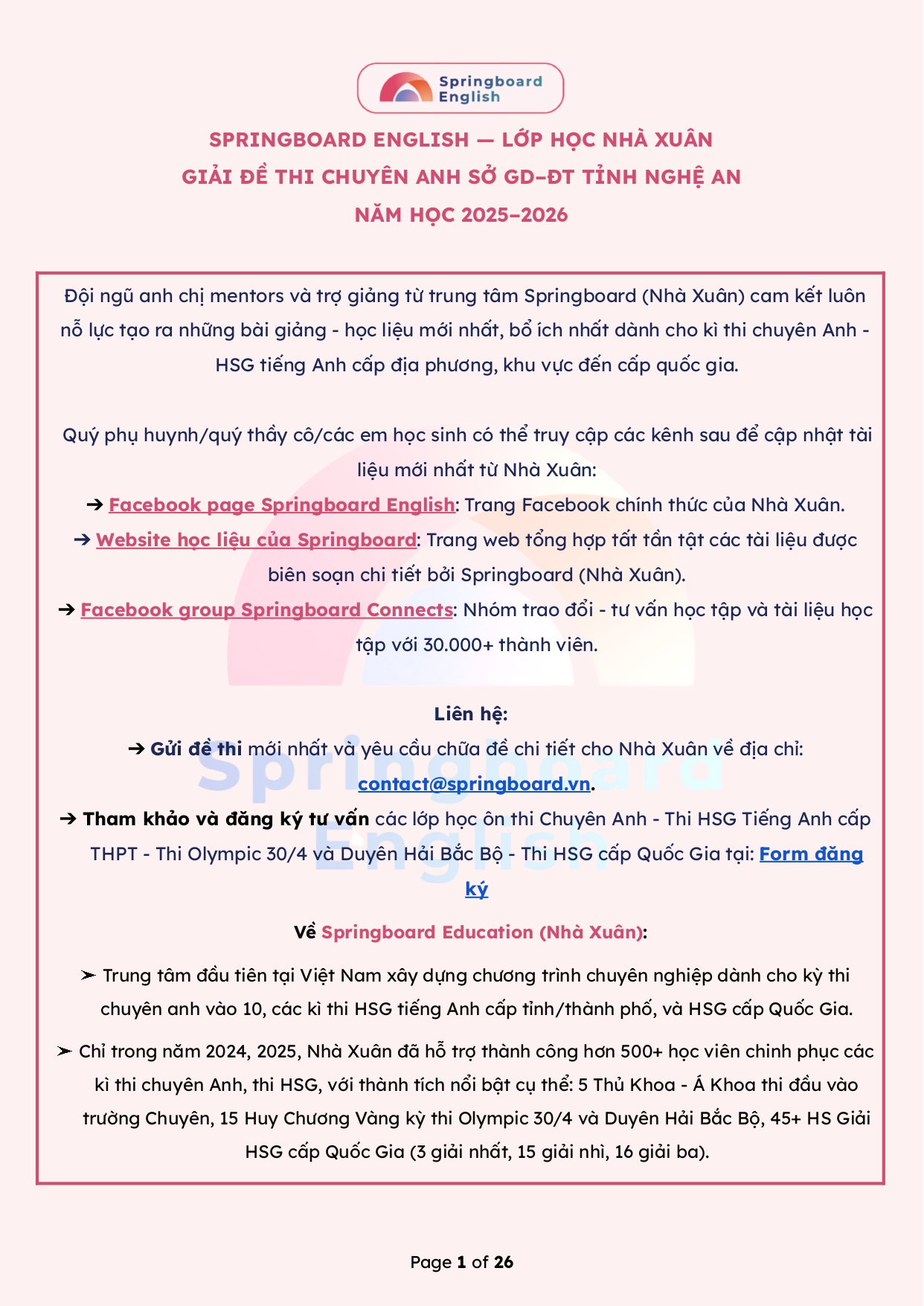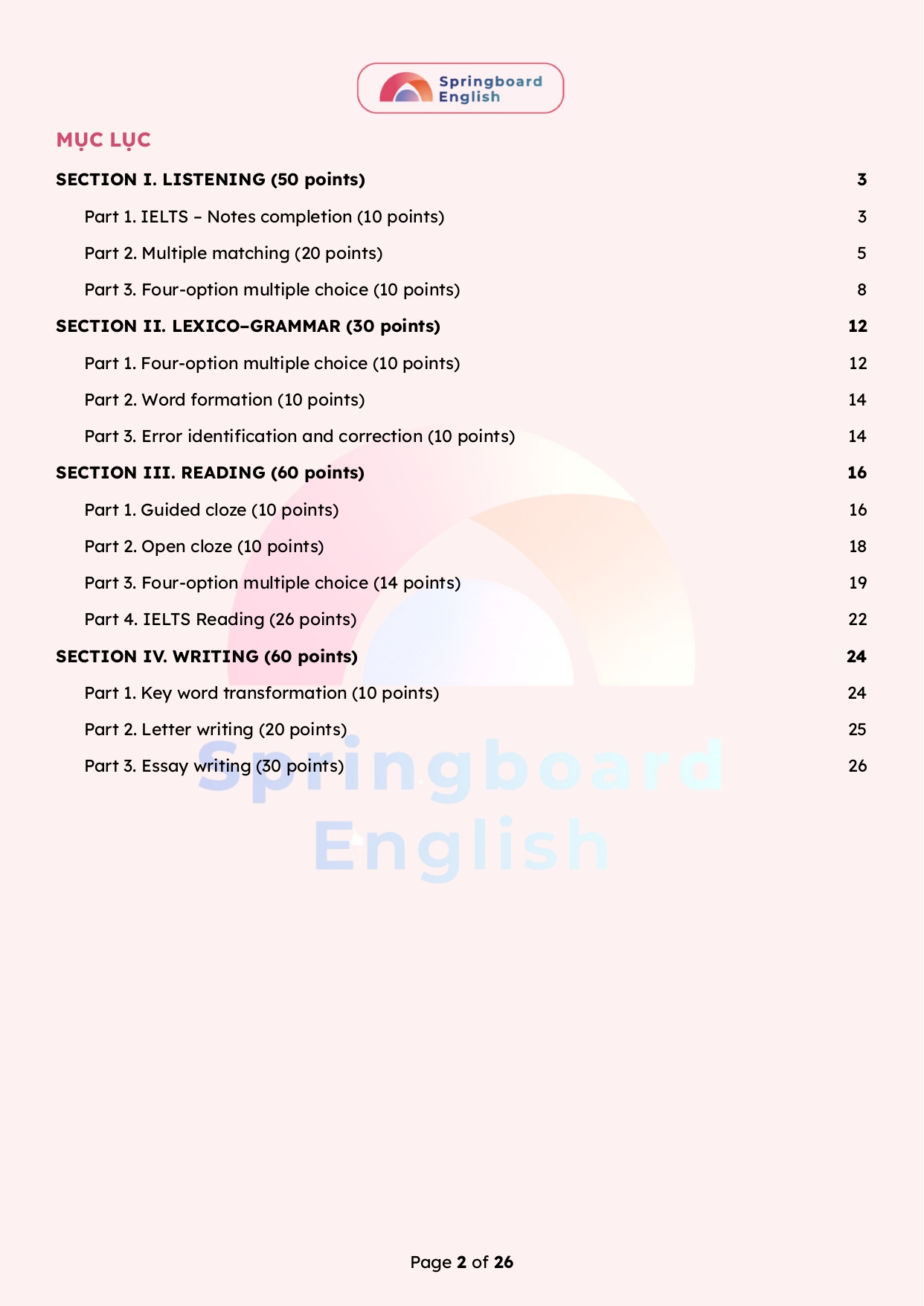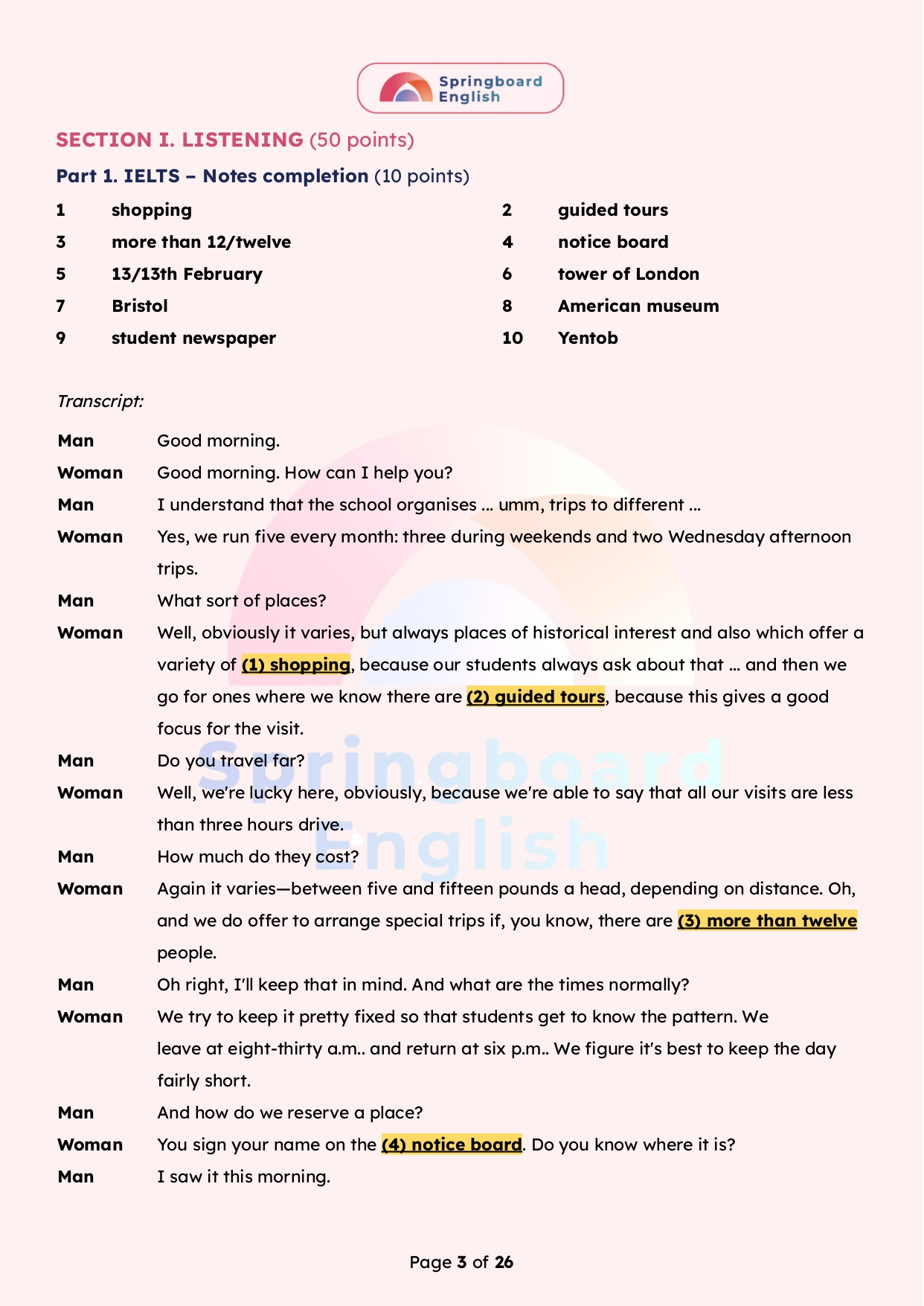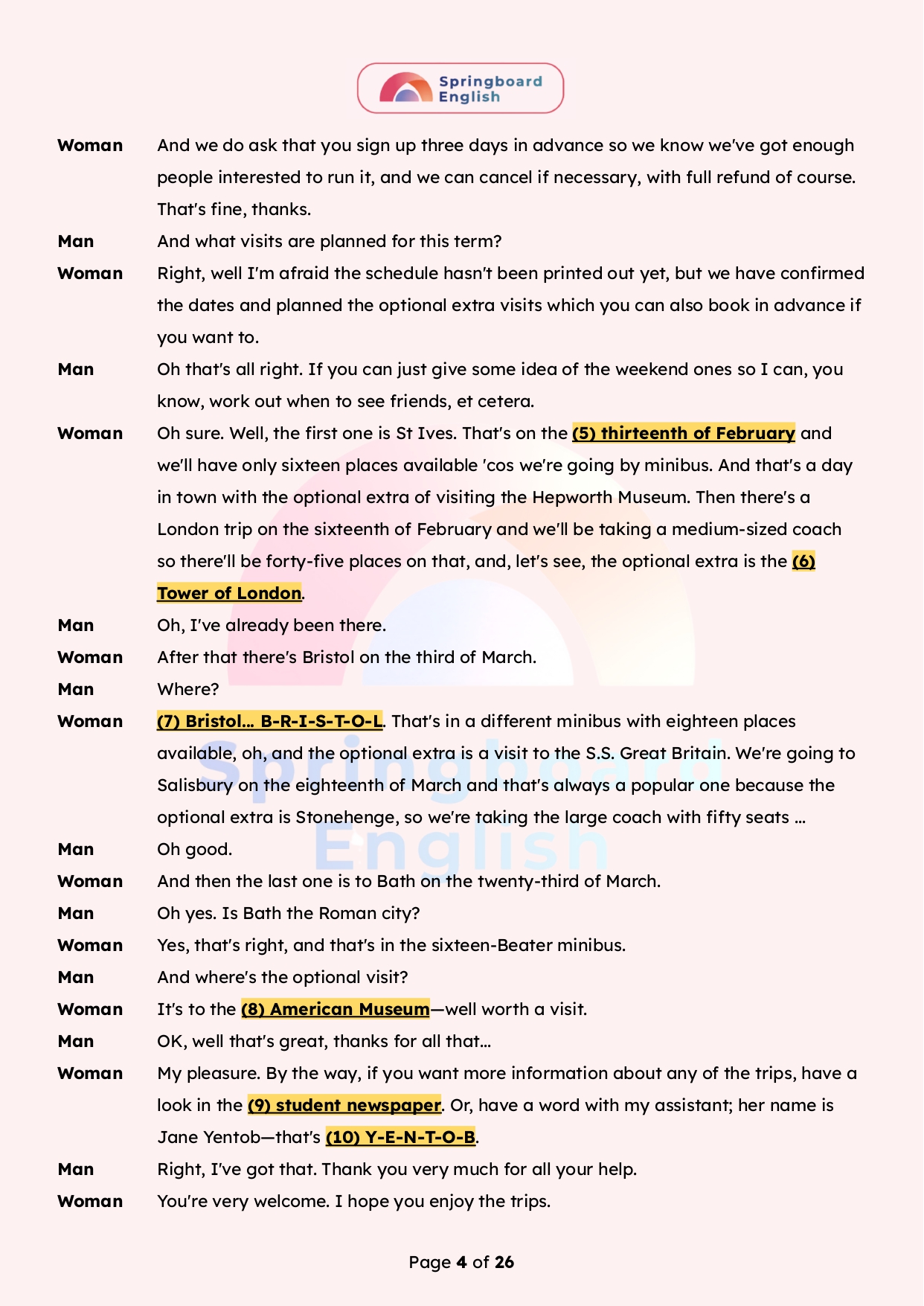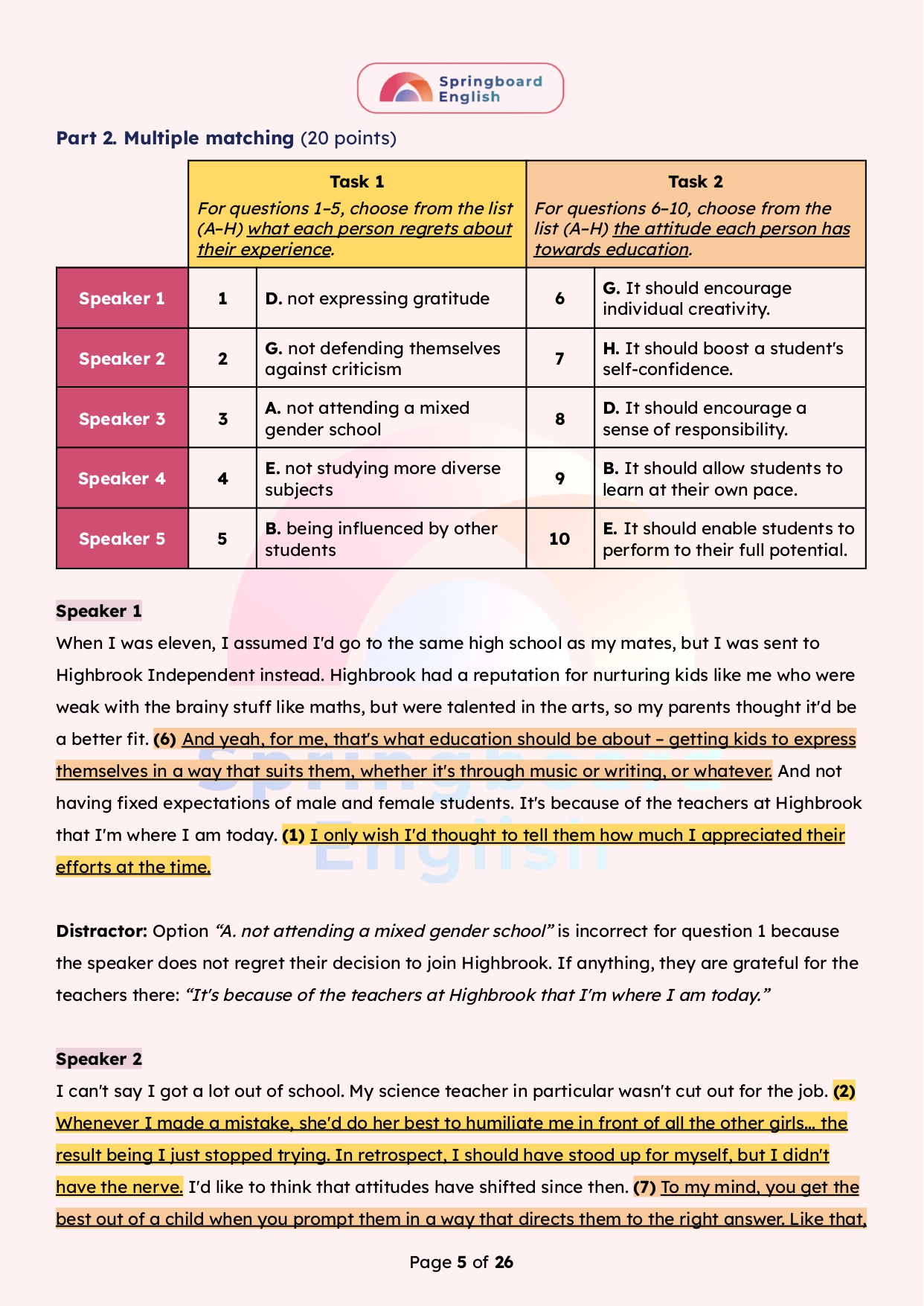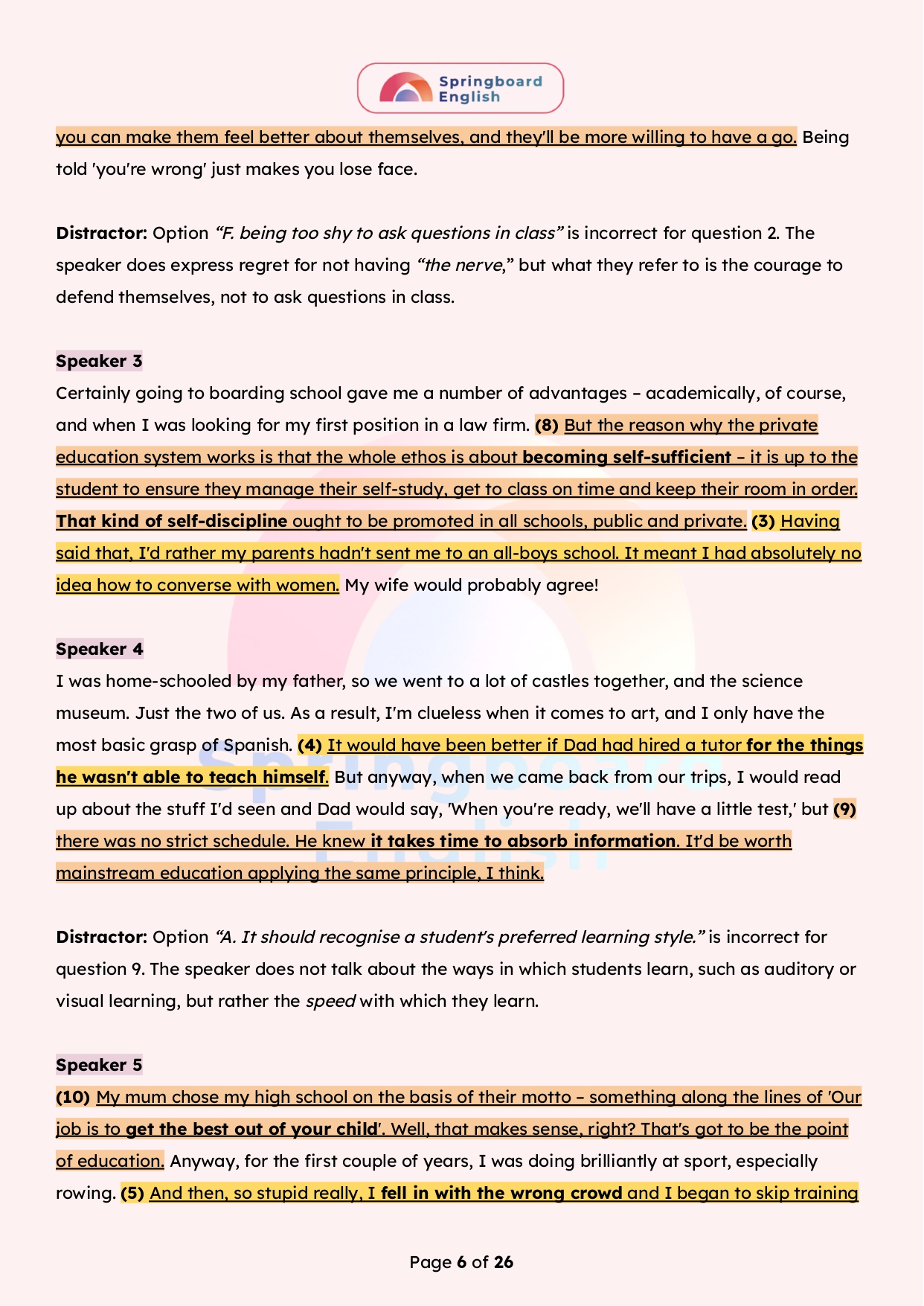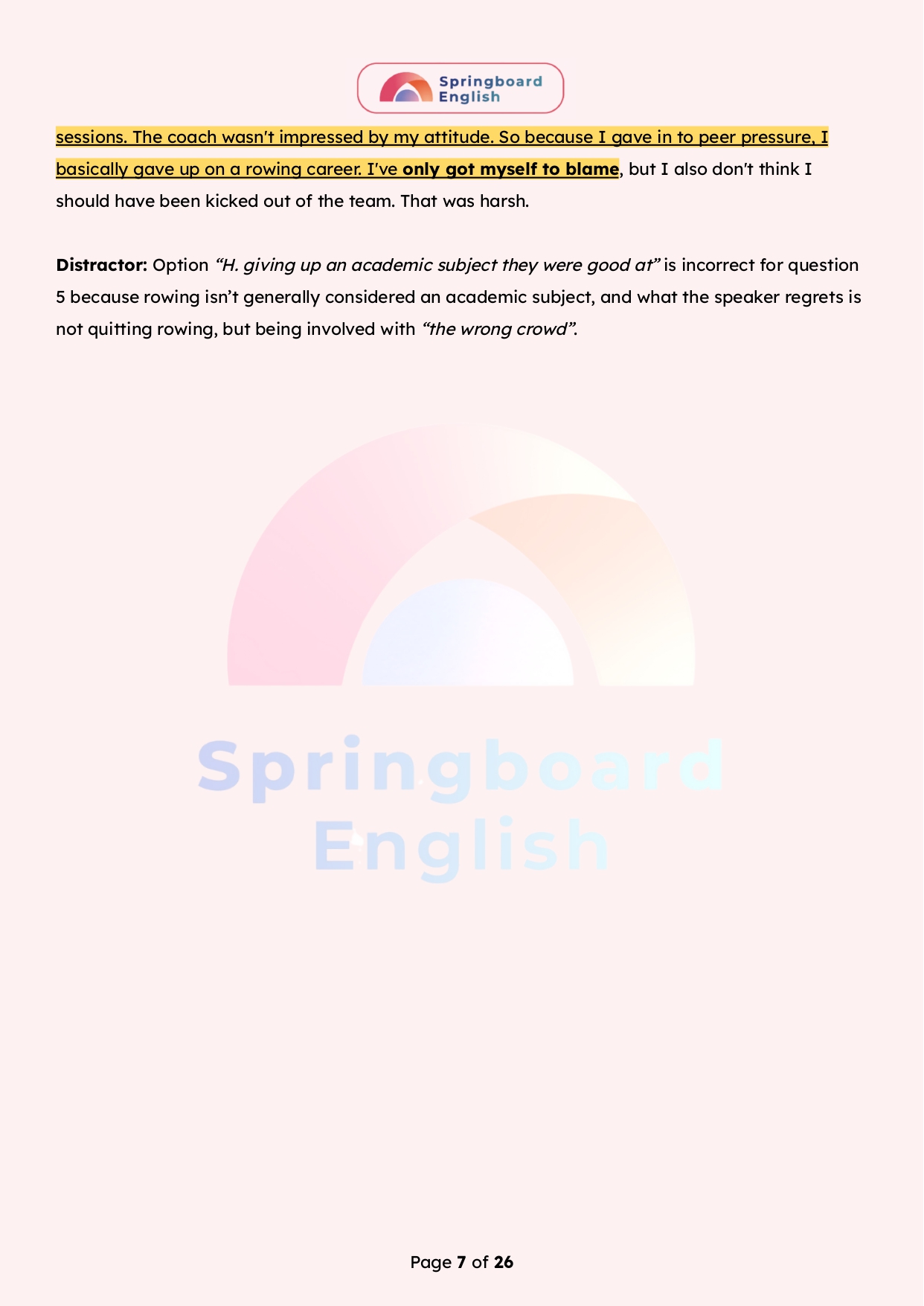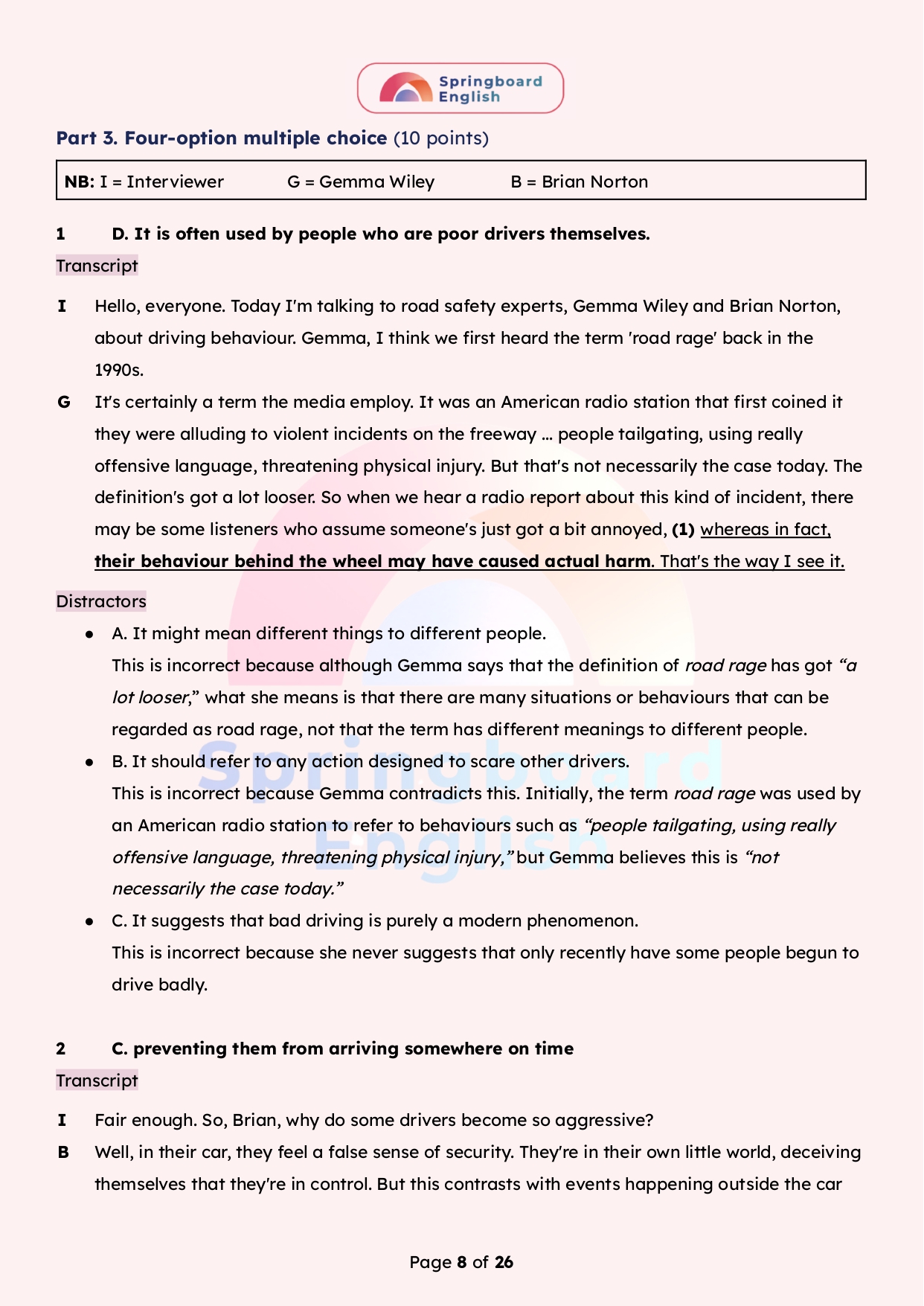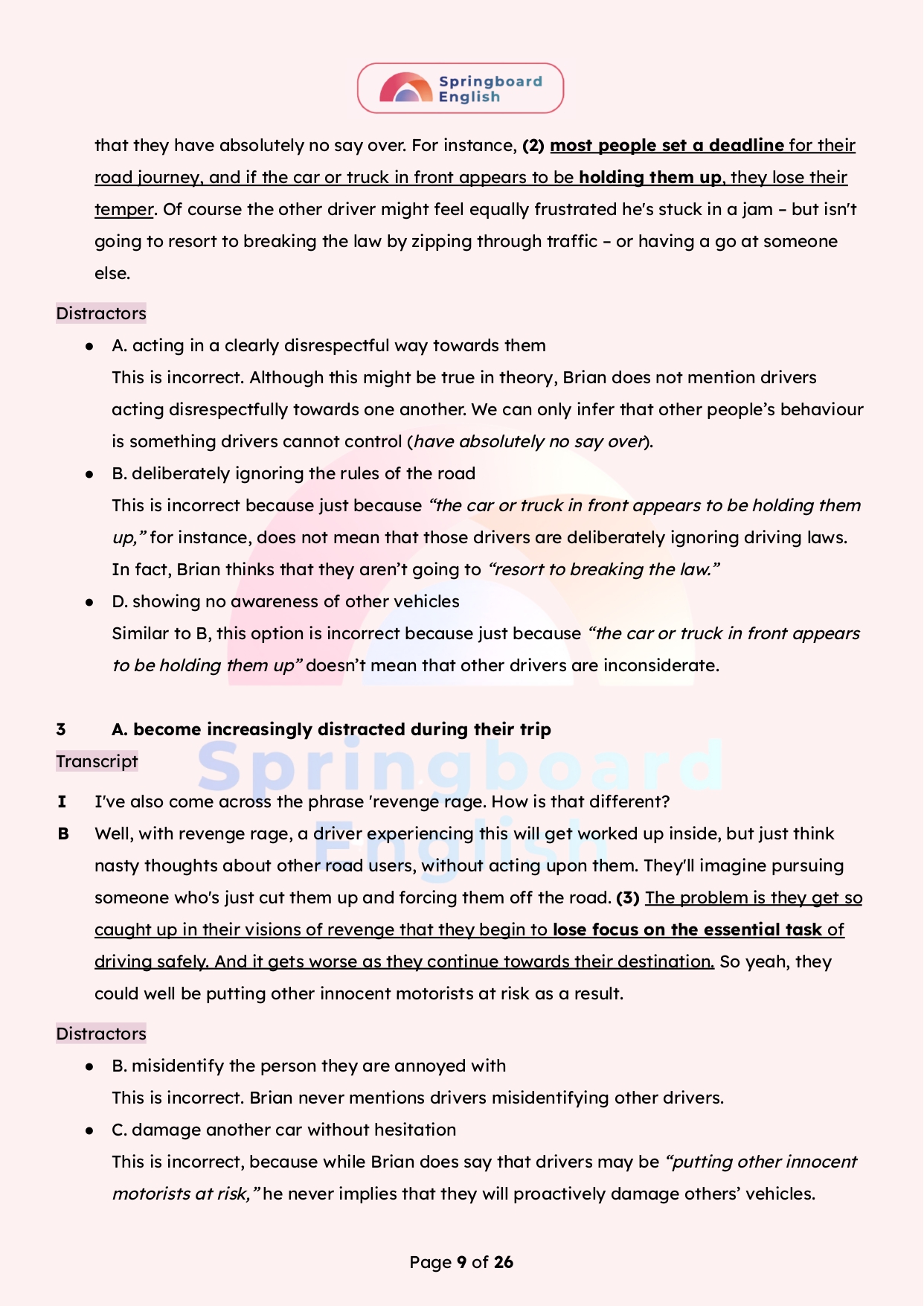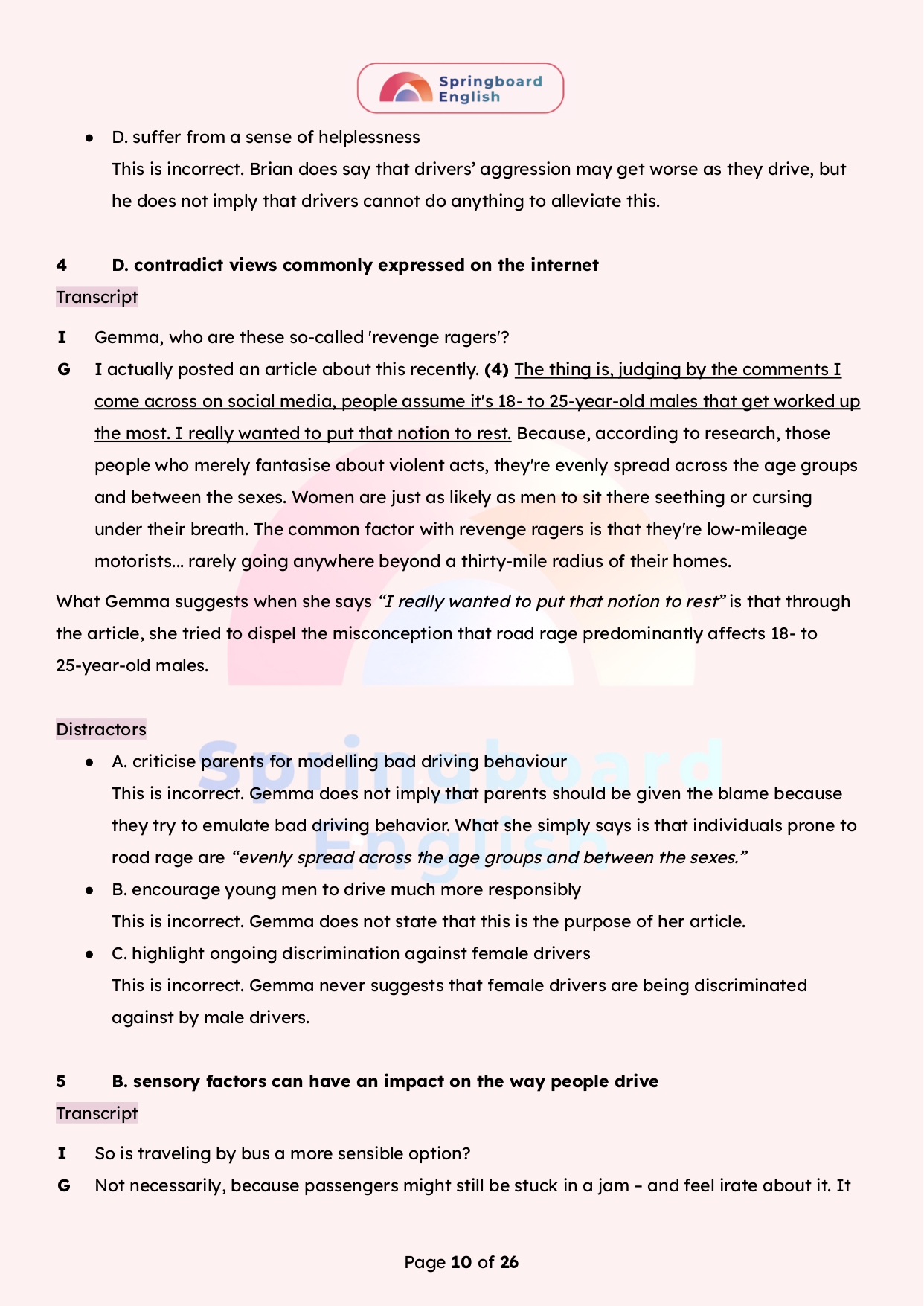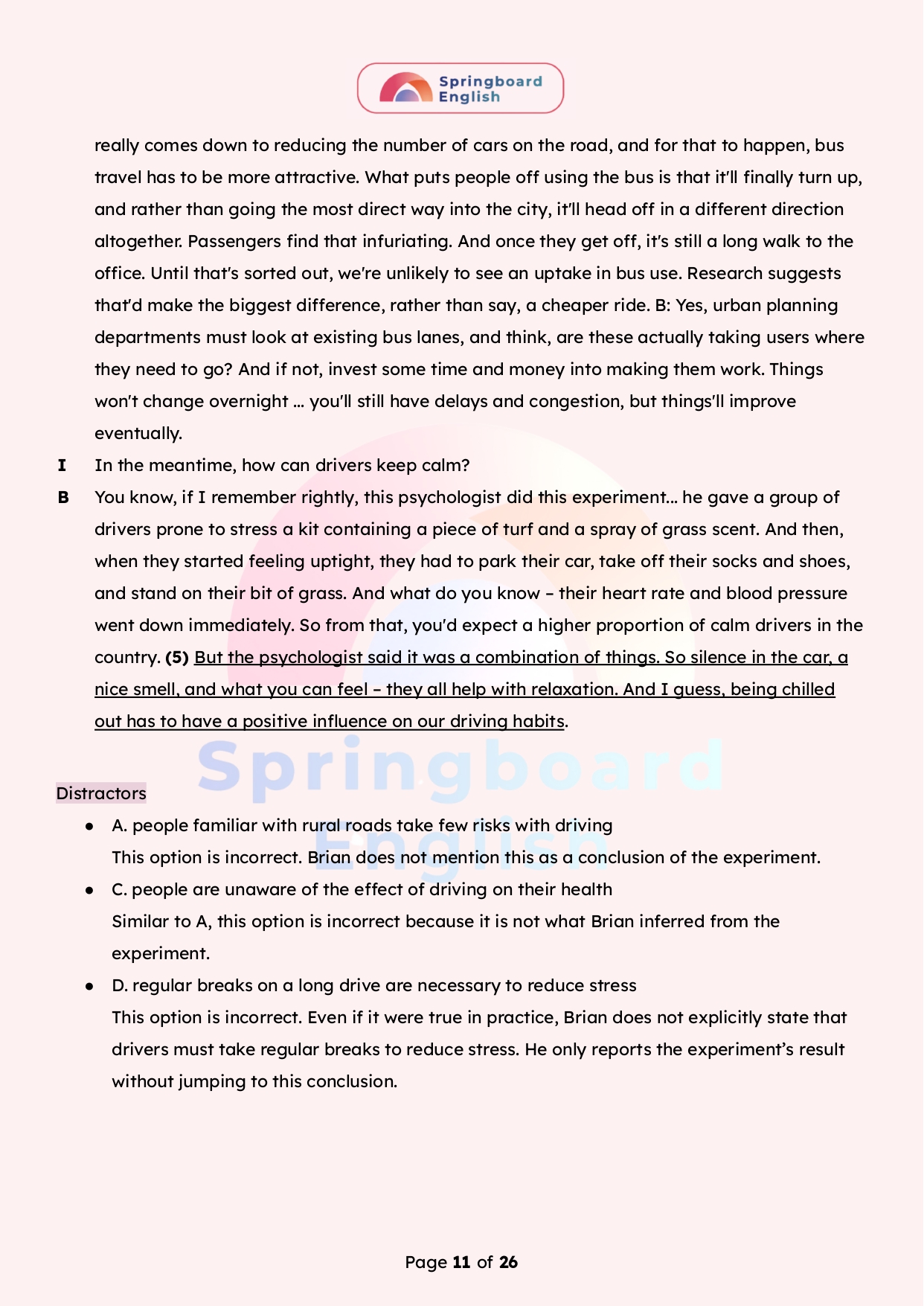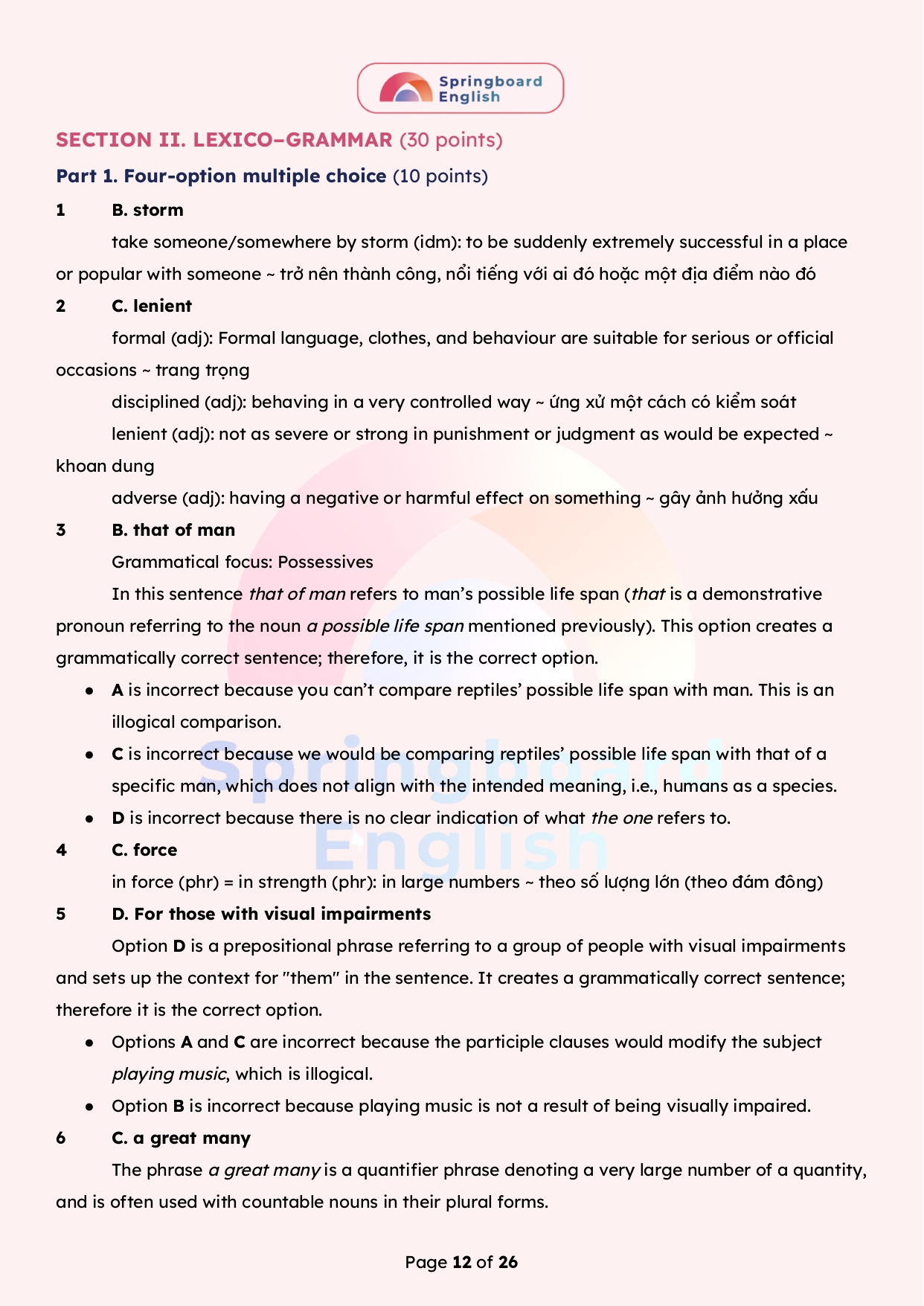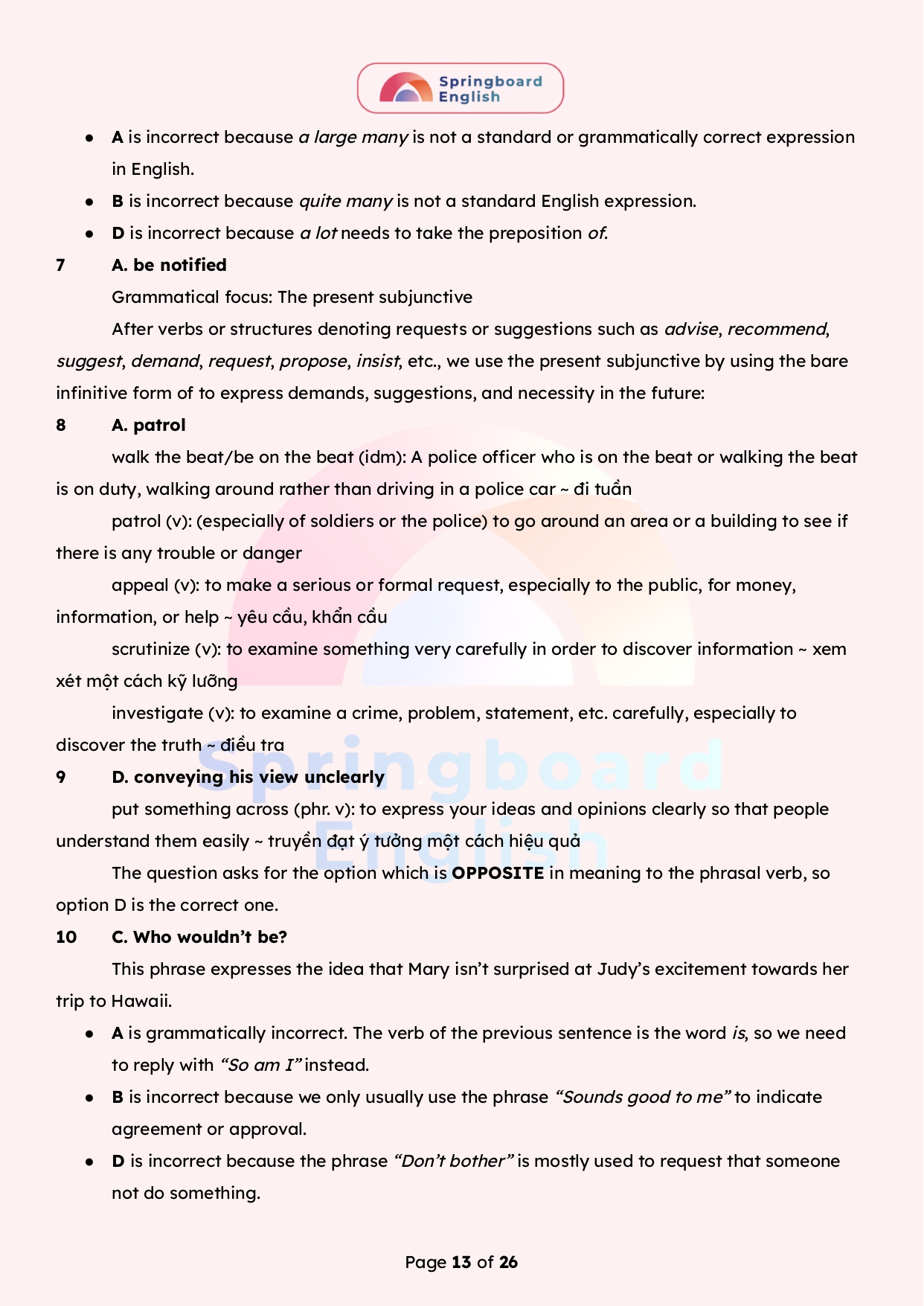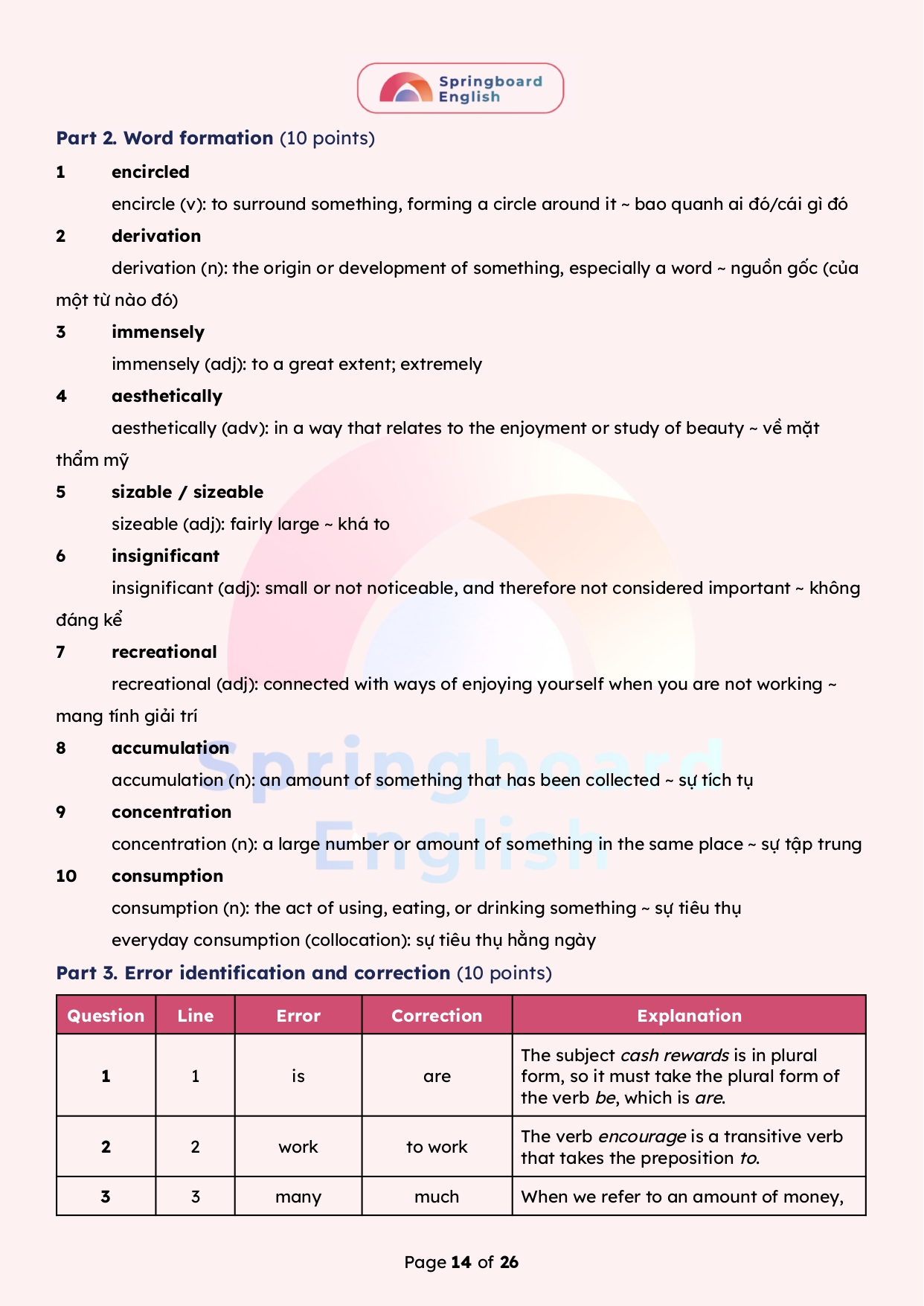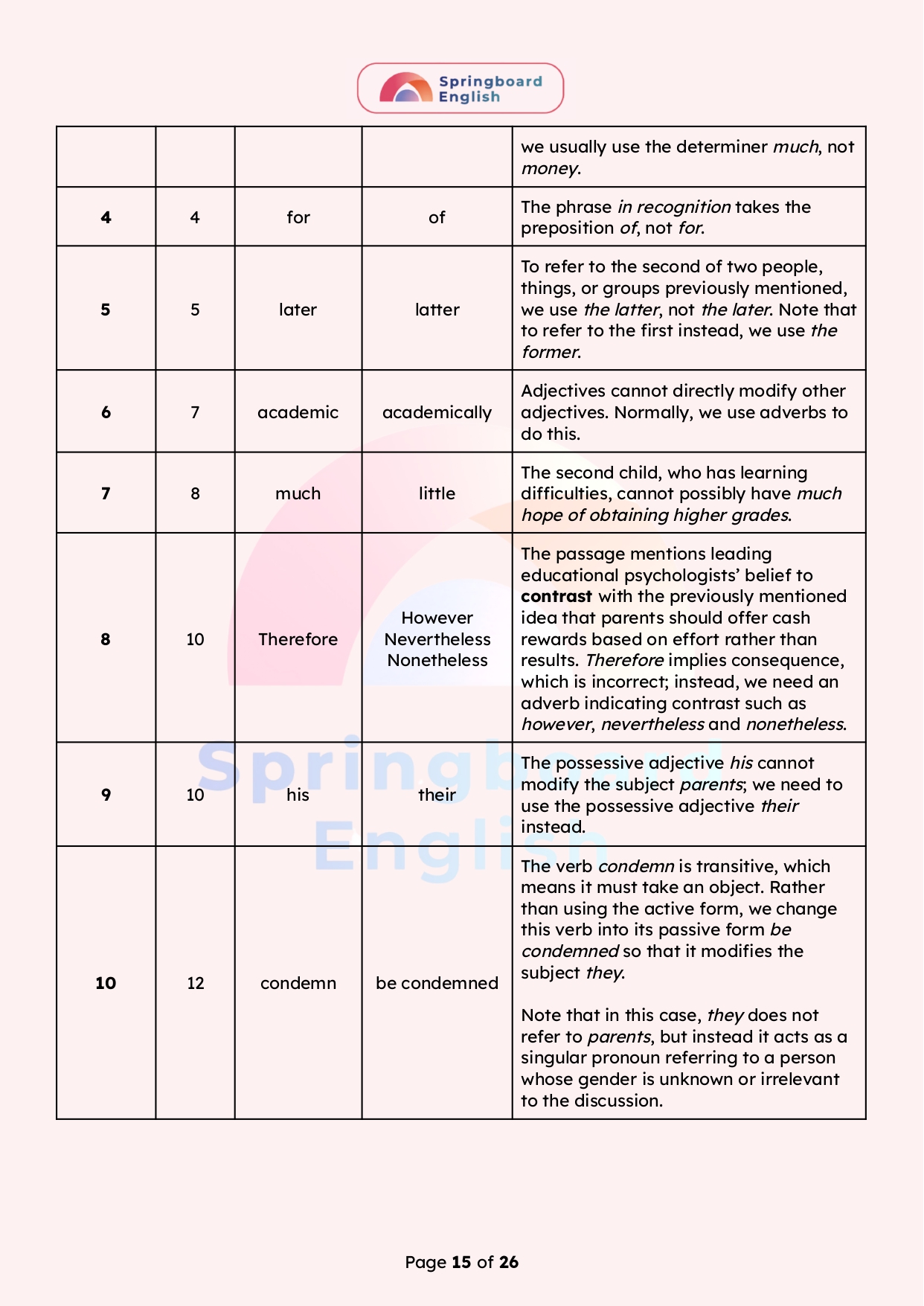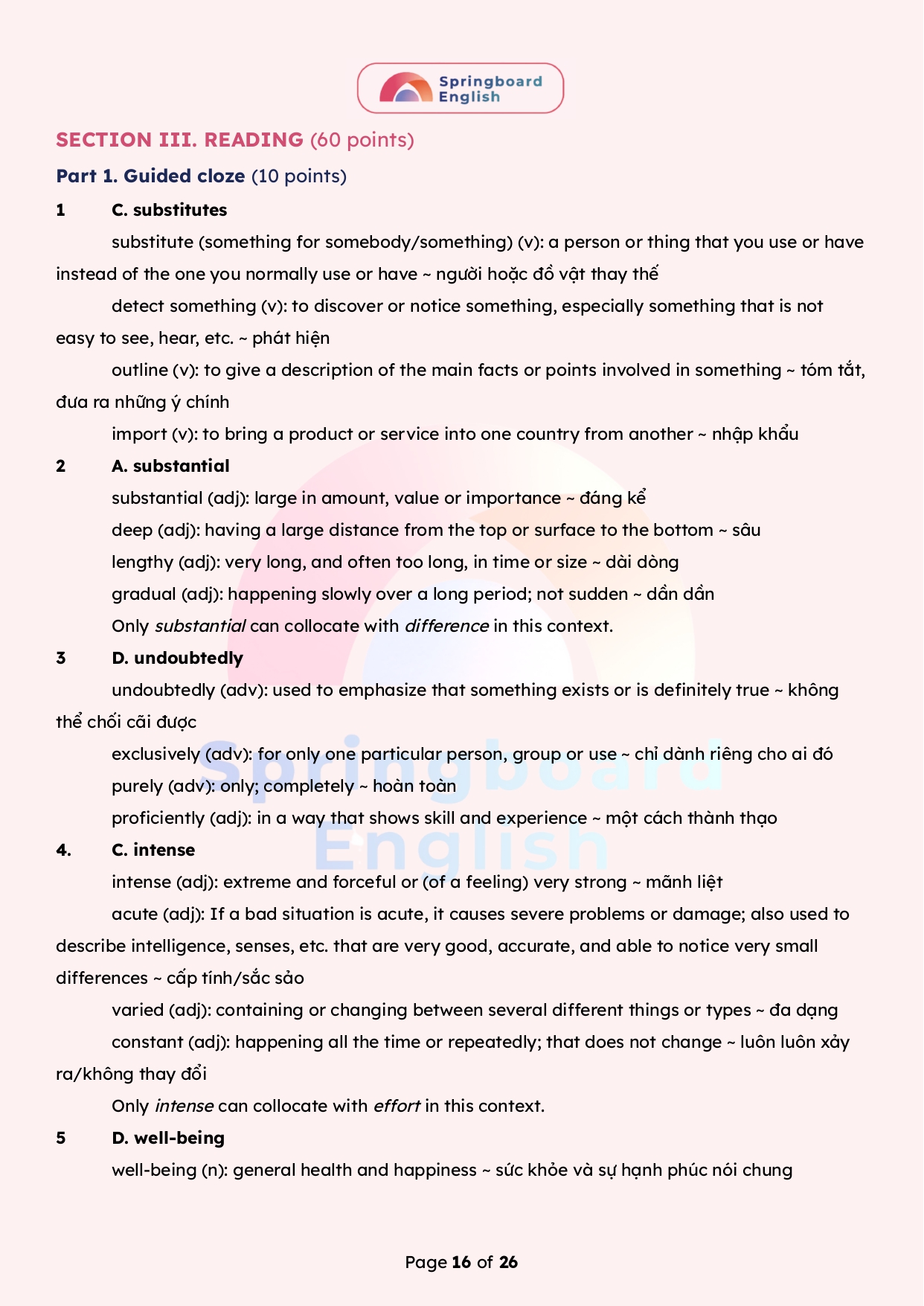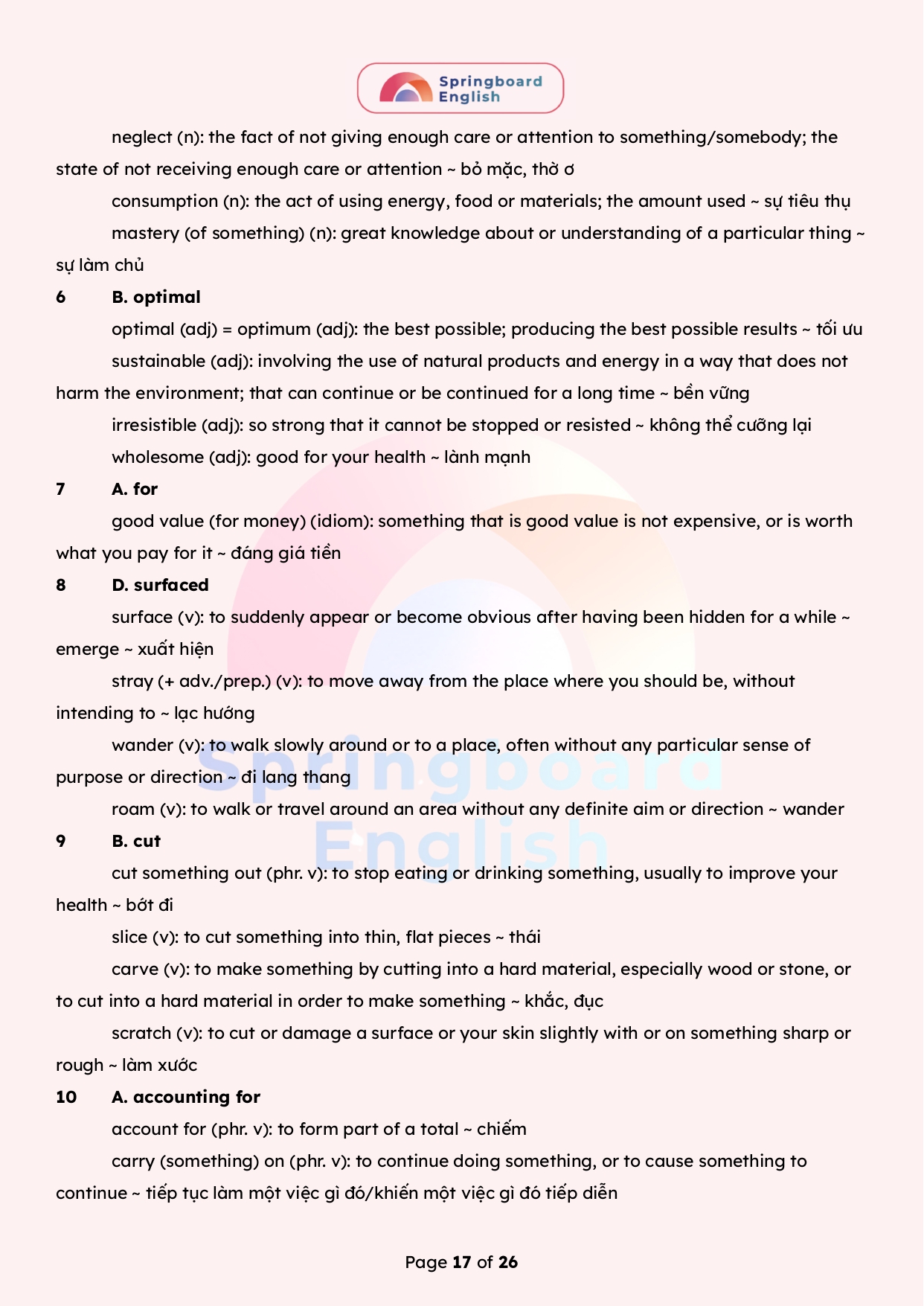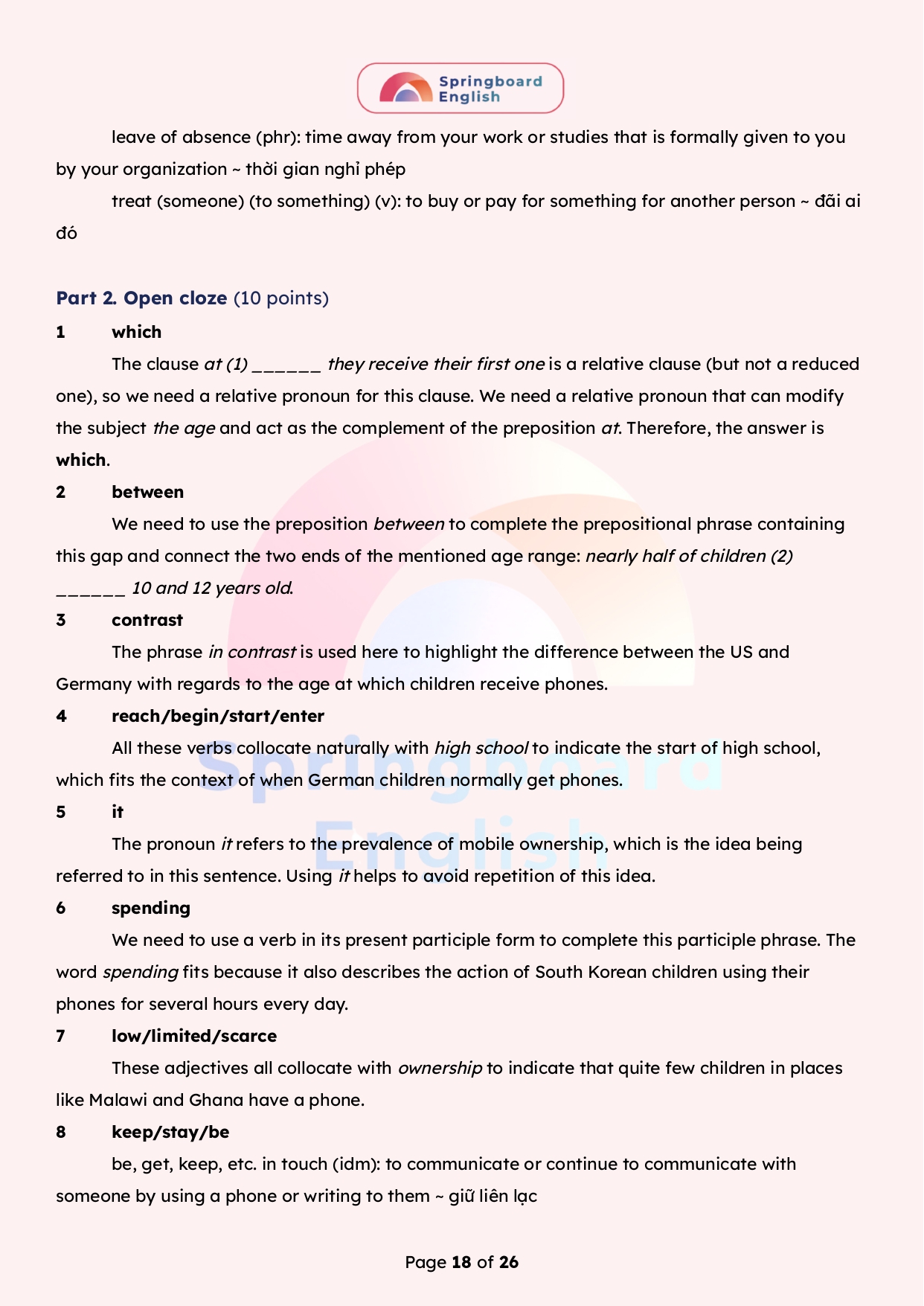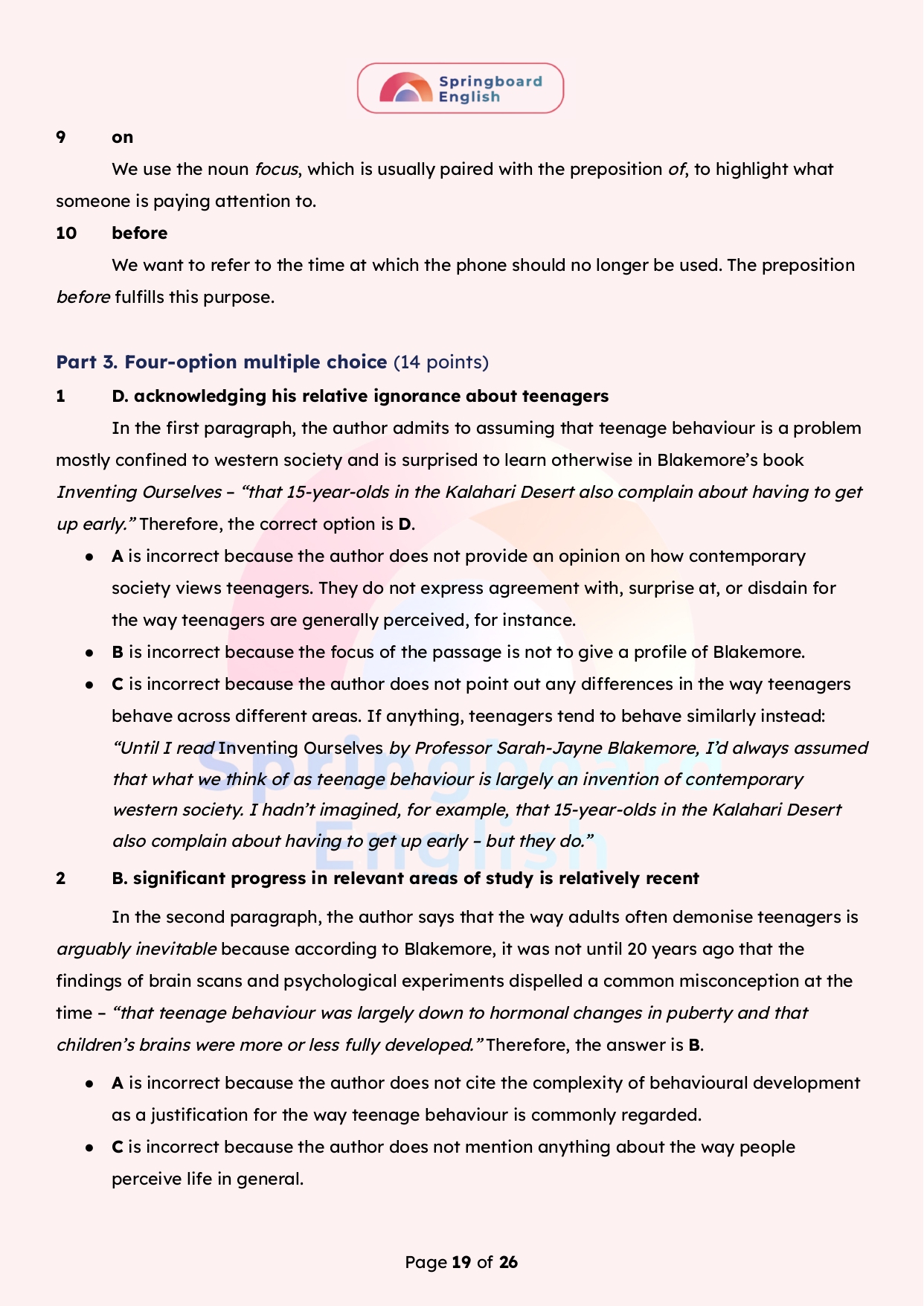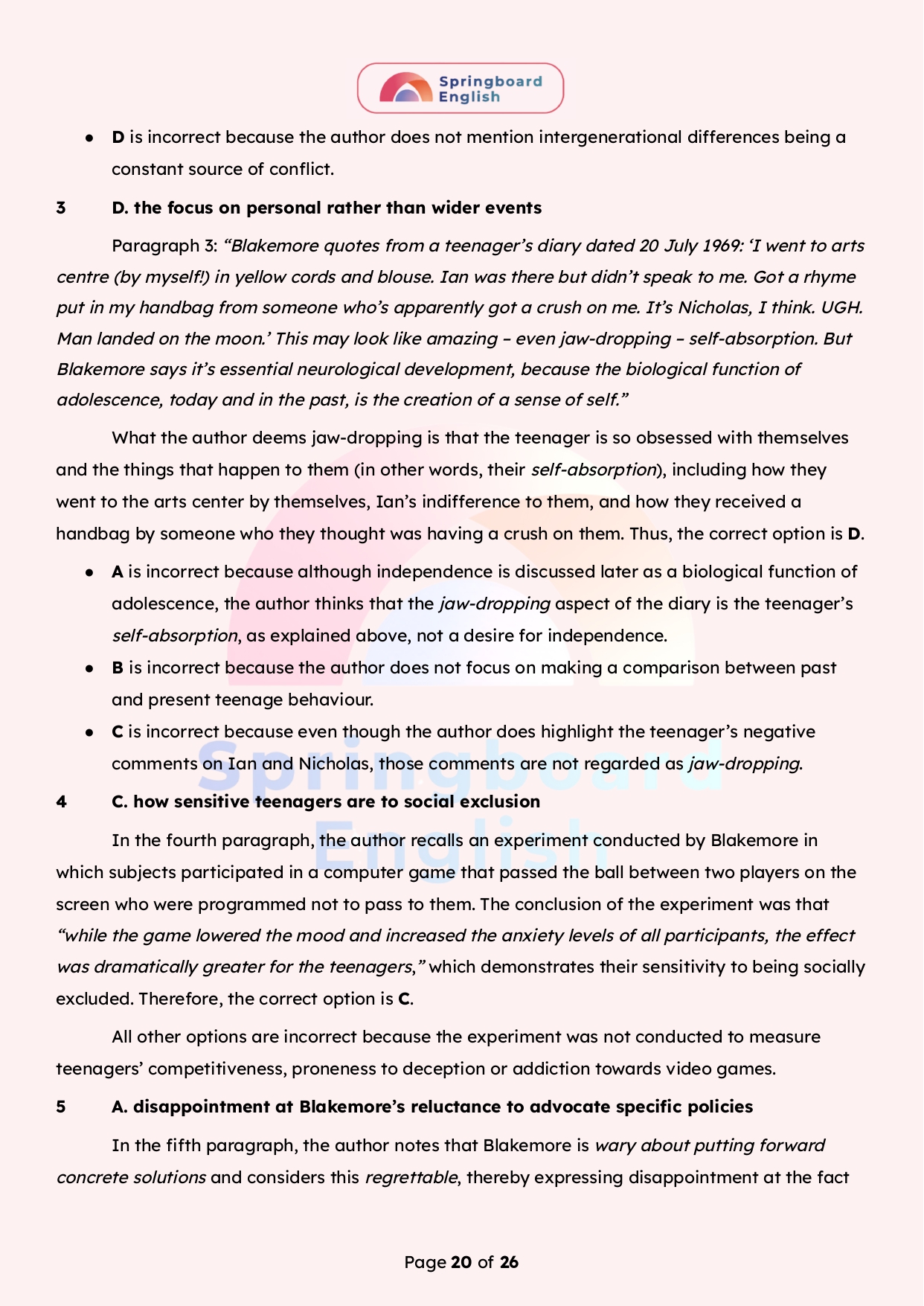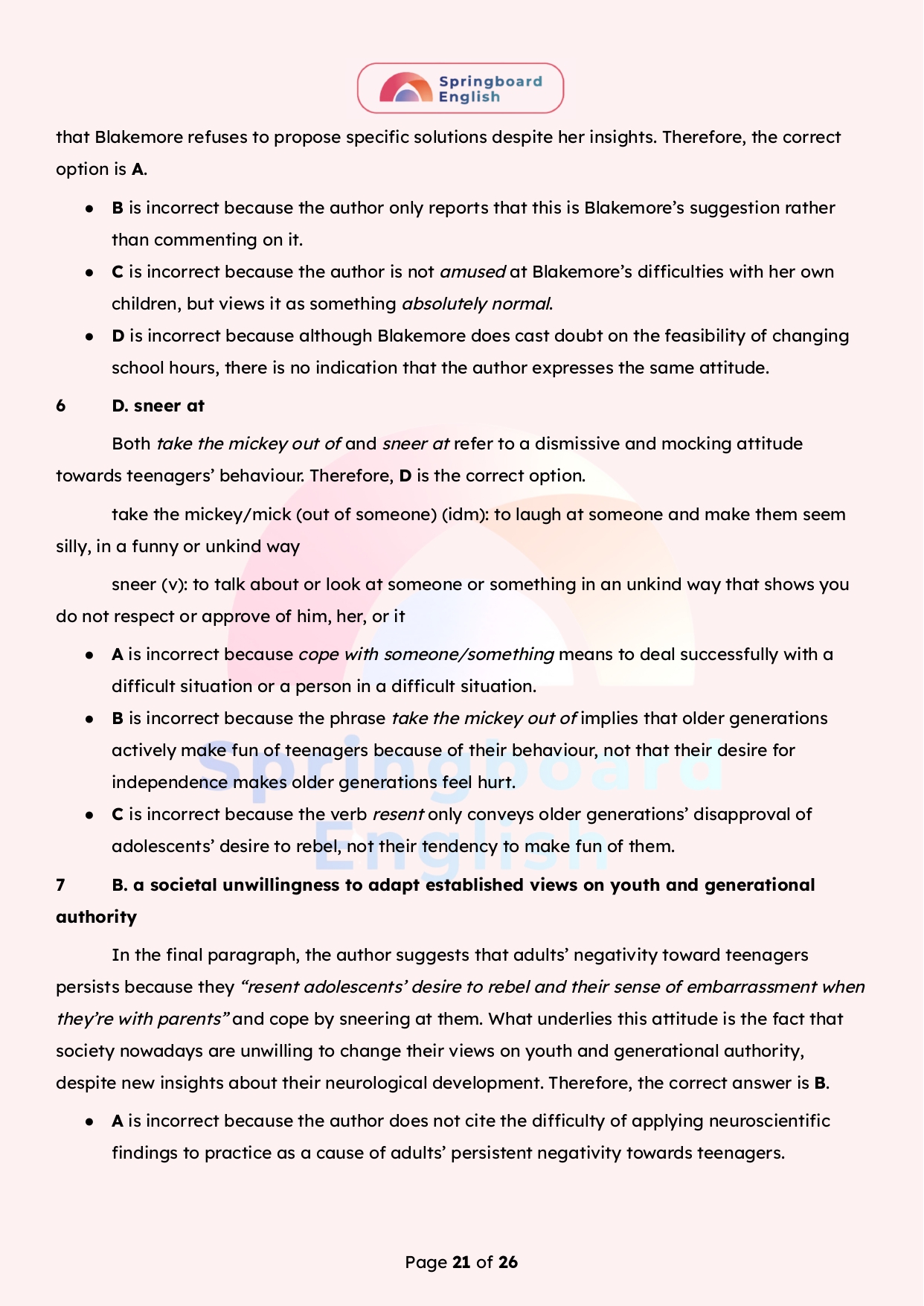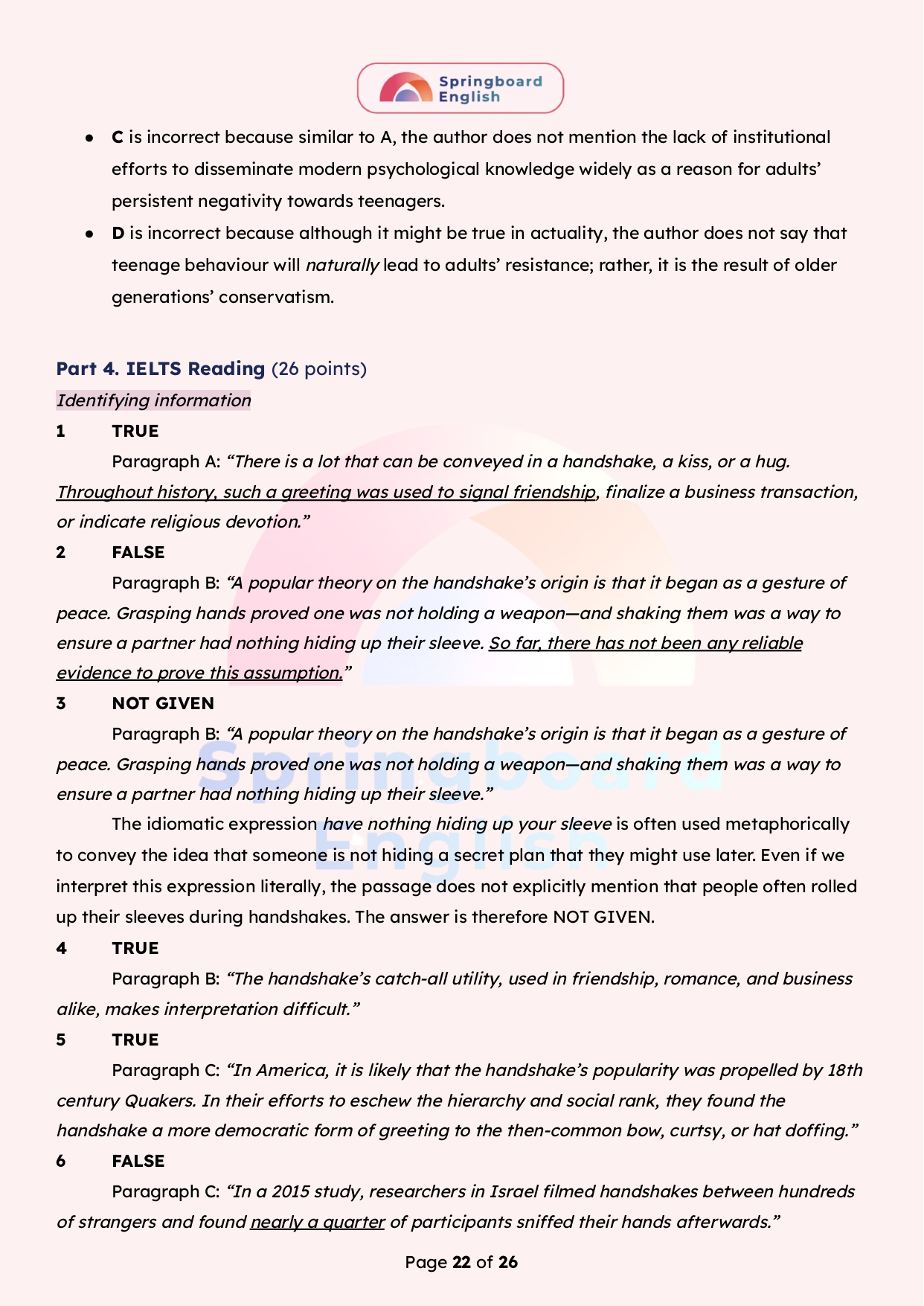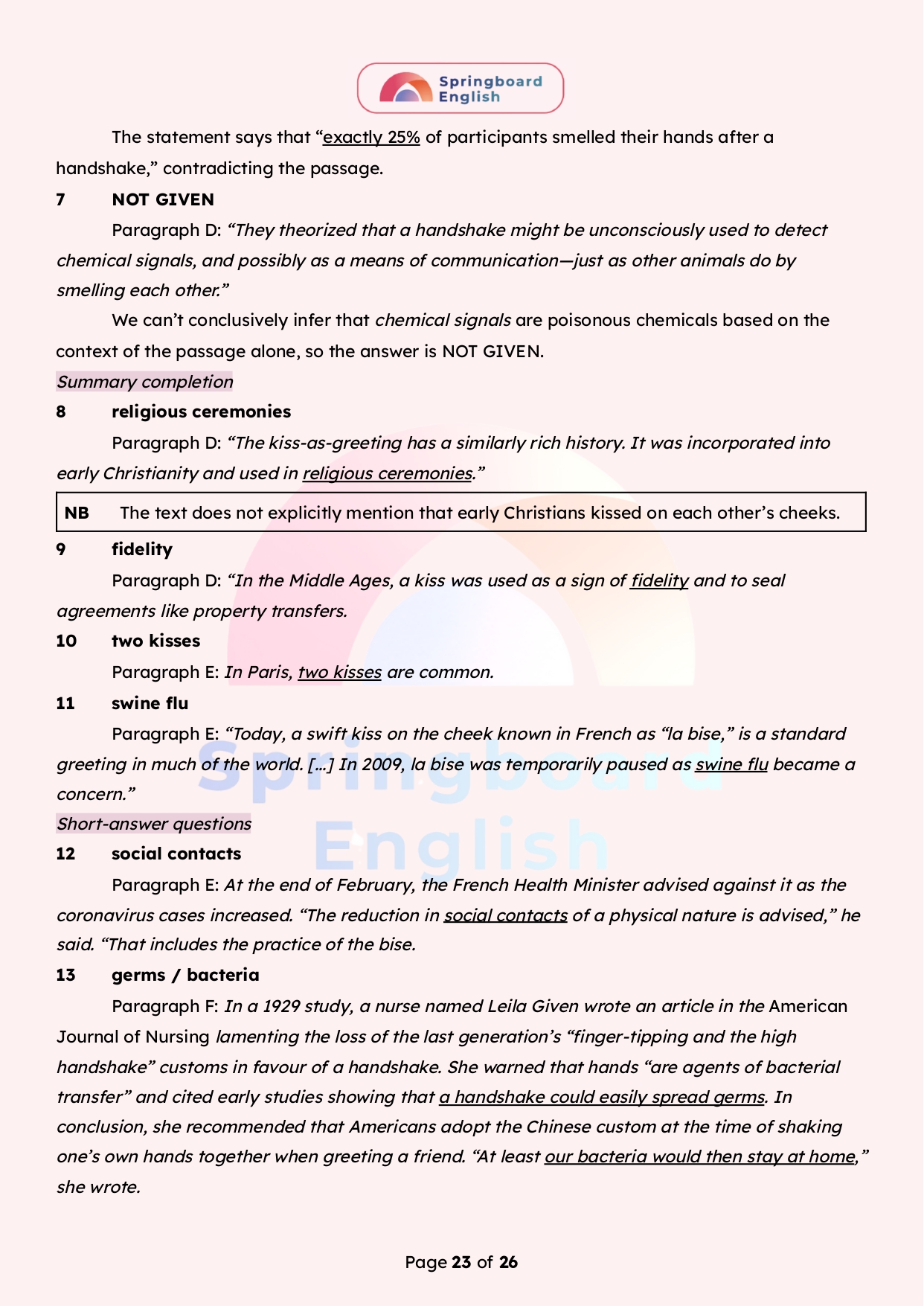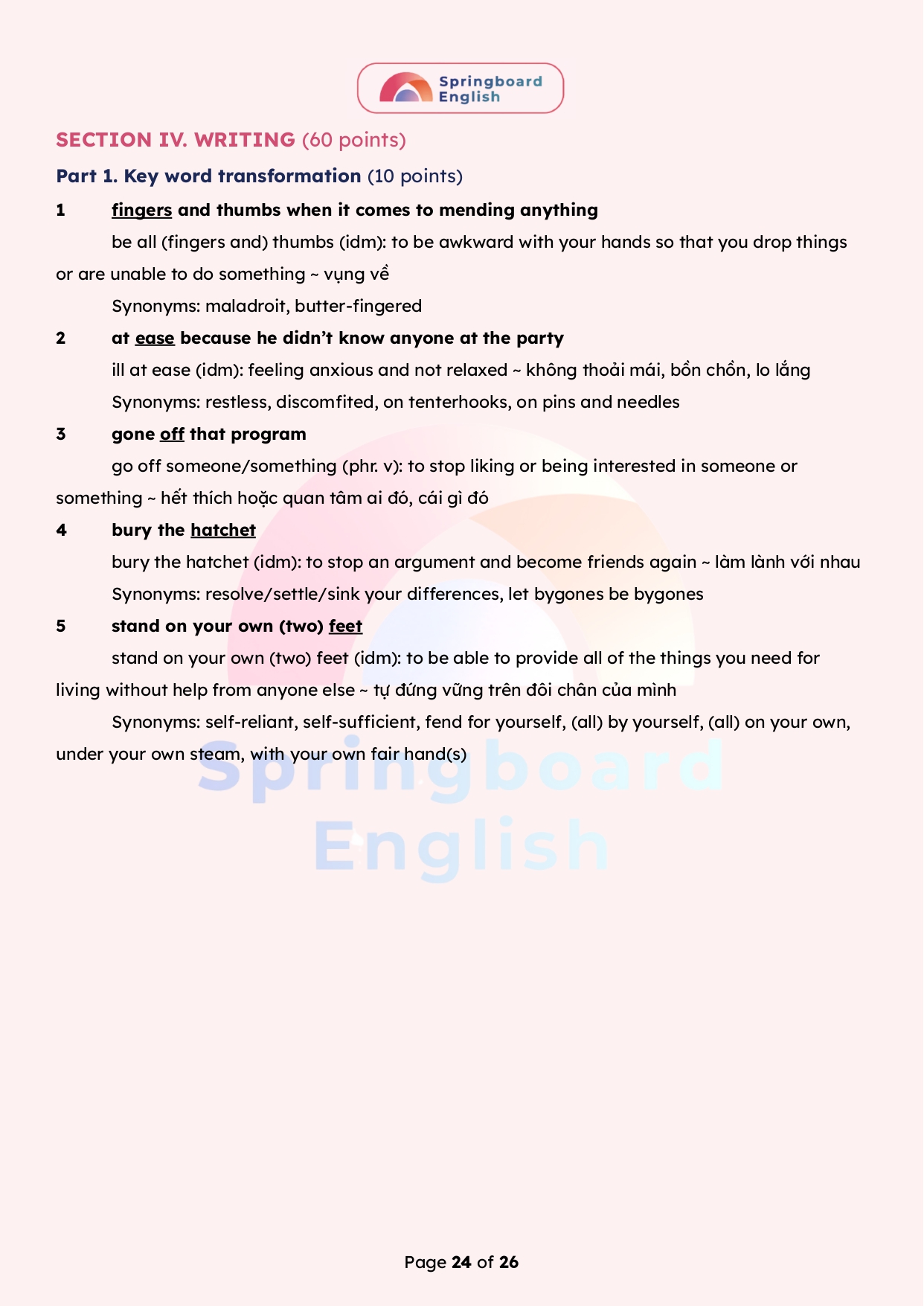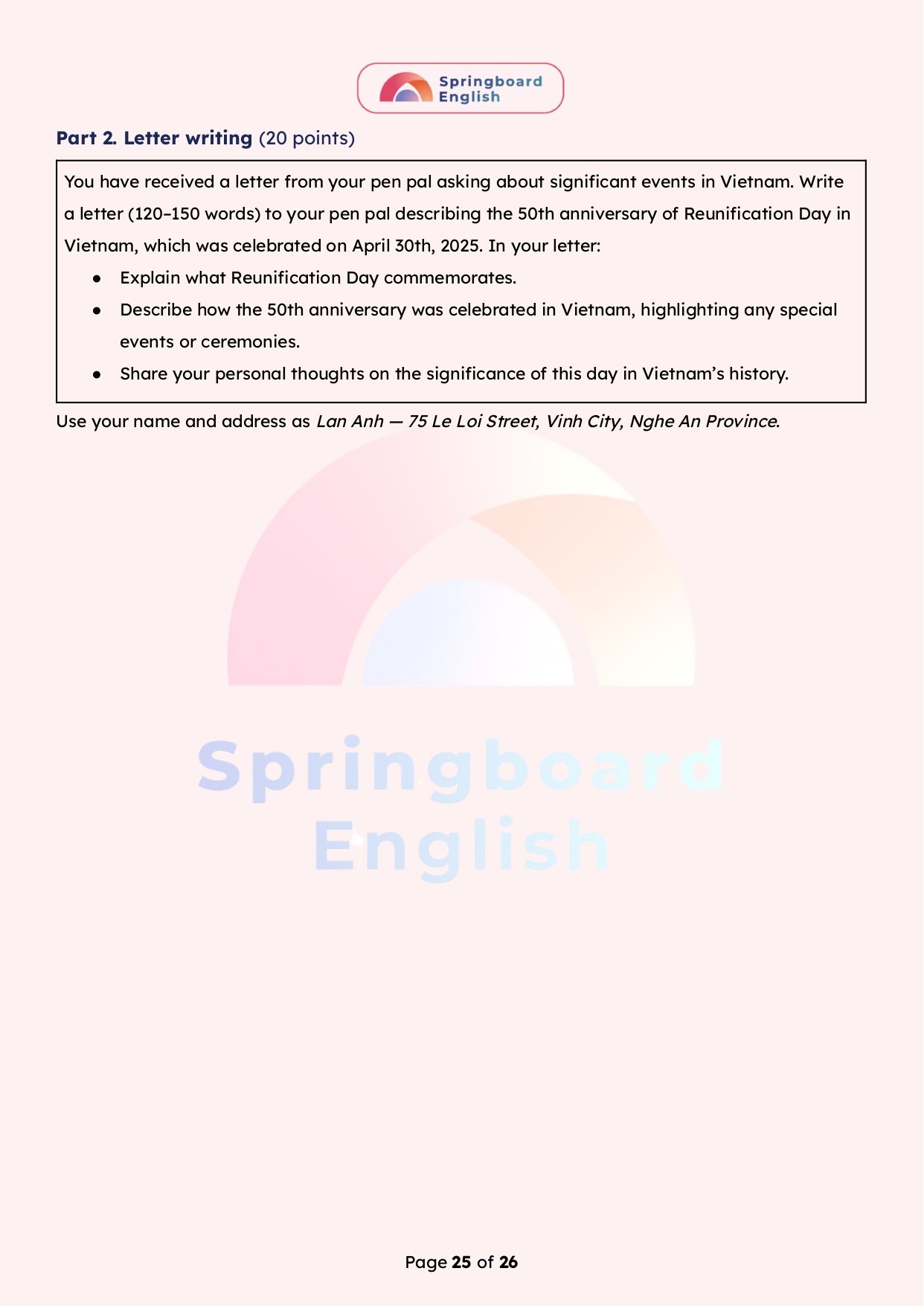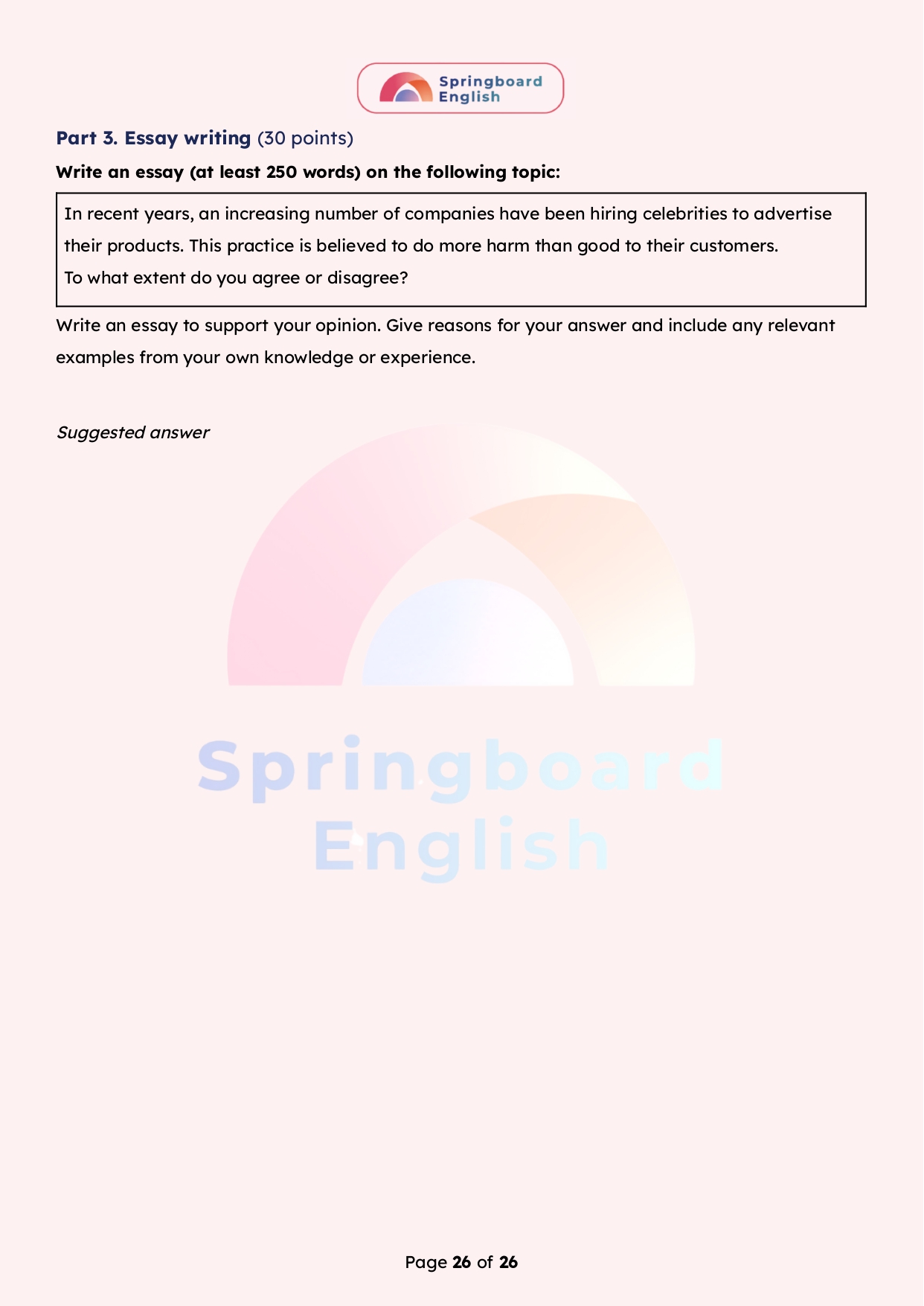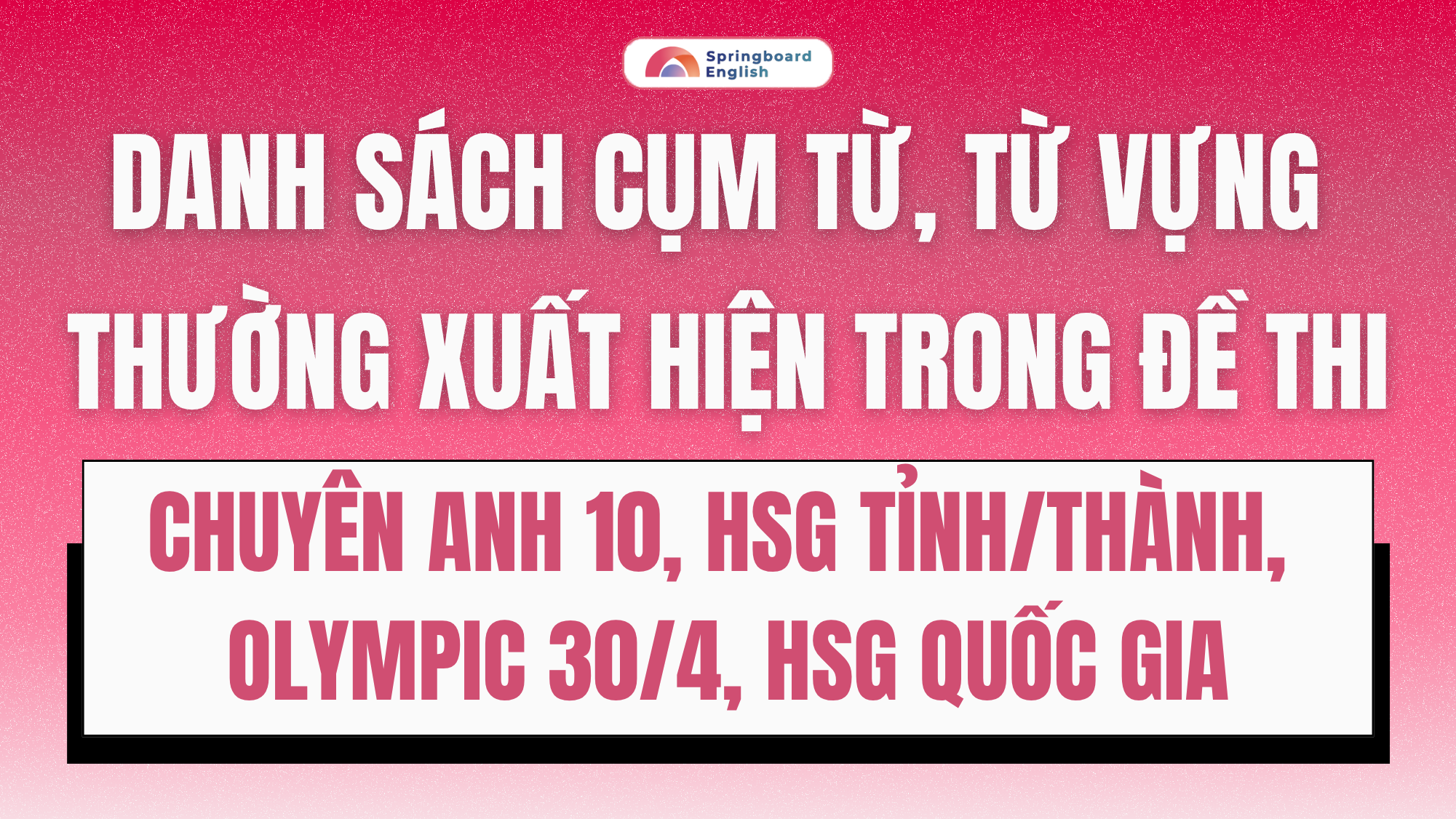Đề thi và Đáp án Chi tiết Kì thi Chuyên Anh 10, Chuyên Anh tỉnh Nghệ An năm 2025-2026
Đội ngũ anh chị trung tâm Springboard (Nhà Xuân) xin gửi đến các quý phụ huynh, thầy cô, các em học sinh tổng hợp đề thi và đáp án đề thi Chuyên Anh vào lớp 10 tỉnh NGHỆ AN, thi vào THPT Chuyên Phan Bội Châu năm 2025-2026 (có đáp án và giải thích chi tiết).
Phần đáp án chi tiết được giới thiệu ở bài viết này là tài liệu được biên soạn trực tiếp bởi đội ngũ chuyên môn Nhà Xuân, đồng thời là bản cập nhật mới nhất trong năm 2025.
Kéo xuống dưới cùng để xem hết đáp án có giải thích chi tiết.
Đề thi Chuyên Anh vào 10, Chuyên Anh tỉnh Nghệ An năm 2025-2026
| SỞ GIÁO DỤC VÀ ĐÀO TẠO NGHỆ AN ĐỀ CHÍNH THỨC | KỲ THI TUYỂN SINH VÀO LỚP 10 TRƯỜNG THPT CHUYÊN PHAN BỘI CHÂU NĂM HỌC 2025 – 2026 MÔN THI: TIẾNG ANH Thời gian: 150 phút, không kể thời gian giao đề |
Đề thi có 12 trang
SECTION A: LISTENING
PART 1. Listen and complete the notes and the table below using NO MORE THAN THREE WORDS AND/OR A NUMBER for each answer. You will listen twice. Write your answers in the boxes provided.
Question 1 – 4:
NOTES ON SOCIAL PROGRAMME
- Visit places which have:
- historical interest
- good (1) ______
- (2) ______
- Cost: between £5.00 and £15.00 per person
- Note: special trips organised for groups of (3) ______ people
- Time: departure – 8.30 a.m and return – 6.00 p.m.
- To reserve a seat: sign name on the (4) ______ 3 days in advance
Question 5 – 10:
| WEEKEND TRIPS | Date | Optional extra |
|---|---|---|
| St Ives | (5) ______ | Hepworth Museum |
| London | 16th February | (6) ______ |
| (7) ______ | 3rd March | S.S. Great Britain |
| Salisbury | 18th March | Stonehenge |
| Bath | 23rd March | (8) ______ |
| For further information: Read the (9) ______ or see Social Assistant: Jane (10) ______ | ||
YOUR ANSWERS:
| 1. ______ | 2. ______ | 3. ______ | 4. ______ | 5. ______ |
| 6. ______ | 7. ______ | 8. ______ | 9. ______ | 10. ______ |
PART 2. You will hear five short extracts in which people are talking about their experience of education. (WHILE LISTENING TO EACH SPEAKER, YOU MUST COMPLETE BOTH TASKS, TASK 1 AND TASK 2 AT THE SAME TIME). You will listen twice. Write your answers in the boxes provided.
TASK 1. For questions 1 – 5, choose from the list (A – H) what each person regrets about their experience.
- A. not attending a mixed gender school
- B. being influenced by other students
- C. losing contact with friends
- D. not expressing gratitude
- E. not studying more diverse subjects
- F. being too shy to ask questions in class
- G. not defending themselves against criticism
- H. giving up an academic subject they were good at
YOUR ANSWERS:
| 1. Speaker 1: ______ | 2. Speaker 2: ______ | 3. Speaker 3: ______ | 4. Speaker 4: ______ | 5. Speaker 5: ______ |
TASK 2. For questions 6-10, choose from the list (A – H) the attitude each person has towards education.
- A. It should recognise a student’s preferred learning style.
- B. It should allow students to learn at their own pace.
- C. It should help students develop practical work-related skills.
- D. It should encourage a sense of responsibility.
- E. It should enable students to perform to their full potential.
- F. It should guide students towards a suitable career.
- G. It should encourage individual creativity.
- H. It should boost a student’s self-confidence.
YOUR ANSWERS:
| 6. Speaker 1: ______ | 7. Speaker 2: ______ | 8. Speaker 3: ______ | 9. Speaker 4: ______ | 10. Speaker 5: ______ |
PART 3. You will hear part of an interview in which two road safety experts called Gemma Wiley and Brian Norton are talking about driving behaviour. For questions 1-5, choose the answer (A, B, C or D) which fits best according to what you hear.
- What point does Gemma make about the term ‘road rage’?
| A. it might mean different things to different people. |
| B. it should refer to any action designed to scare other drivers. |
| C. it suggests that bad driving is purely a modern phenomenon. |
| D. it is often used by people who are poor drivers themselves. |
- Brian says some drivers become aggressive when they think other people are ______.
| A. acting in a clearly disrespectful way towards them |
| B. deliberately ignoring the rules of the road |
| C. preventing them from arriving somewhere on time |
| D. showing no awareness of other vehicles |
- Brian is concerned that drivers experiencing ‘revenge rage’ may ______.
| A. become increasingly distracted during their trip |
| B. misidentify the person they are annoyed with |
| C. damage another car without hesitation |
| D. suffer from a sense of helplessness |
- Gemma posted an article about ‘revenge ragers’ in order to ______.
| A. criticise parents for modelling bad driving behaviour |
| B. encourage young men to drive much more responsibly |
| C. highlight ongoing discrimination against female drivers |
| D. contradict views commonly expressed on the internet |
- When talking about the psychologist’s experiment, Brian explains that ______.
| A. people familiar with rural roads take few risks with driving |
| B. sensory factors can have an impact on the way people drive |
| C. people are unaware of the effect of driving on their health |
| D. regular breaks on a long drive are necessary to reduce stress |
YOUR ANSWERS:
| 1. ______ | 2. ______ | 3. ______ | 4. ______ | 5. ______ |
SECTION B: LEXICO- GRAMMAR
PART 1. Choose the word or phrase that best completes each sentence. Write your answer A, B, C or D in the boxes provided.
- Vietnamese singer Hoa Minzy’s latest music video, Bac Bilng, has taken the internet by ______, captivating audiences with its perfect fusion of traditional Vietnamese culture and modern music production.
| A. wind |
| B. storm |
| C. breeze |
| D. tornado |
- While teachers at the school are not particularly strict, they are never ______ with students who skip classes or cheat on tests.
| A. formal |
| B. disciplined |
| C. lenient |
| D. adverse |
- Marine reptiles are among the few creatures that are known to have a possible life span greater than ______.
| A. man |
| B. that of man |
| C. the man’s |
| D. the one of man’s |
- People turned out in ______ to watch the parade on the 50th anniversary of Reunification Day in Vietnam.
| A. volume |
| B. mass |
| C. force |
| D. bulk |
- ______, playing music is an effective way for them to open their heart to the outside world.
| A. Being visually impaired people |
| B. Such were their visual impairments |
| C. Having been visually impaired |
| D. For those with visual impairments |
- There are ______ words in English having more than one meaning. Pay close attention to this fact.
| A. a large many |
| B. quite many |
| C. a great many |
| D. quite a lot |
- It’s very important that we ______ as soon as there’s any change in the patient’s condition.
| A. be notified |
| B. being notified |
| C. are notified |
| D. were notified |
- Choose the word from A, B, C, or D that are CLOSEST in meaning to the underlined words in the following question.
Police officers walk the beat every night in order to make sure no one is committing a crime.
| A. patrol |
| B. appeal |
| C. scrutinise |
| D. investigate |
- Choose the words from A, B, C, or D that is OPPOSITE in meaning to the underlined words in the following question.
Always willing to talk to the media, and skilled in putting his view across, he reserved most of his energies for negotiations at the highest political levels.
| A. communicating his view effectively |
| B. disapproving his opinion |
| C. explaining his ideas clearly |
| D. conveying his view unclearly |
- Choose the option from A, B, C, or D that best completes the following exchange.
Tom: “Judy is so excited about her trip to Hawaii.”
Mary: “______”
| A. So do I. |
| B. Sounds good to me. |
| C. Who wouldn’t be? |
| D. Don’t bother! |
YOUR ANSWERS:
| 1. ______ | 2. ______ | 3. ______ | 4. ______ | 5. ______ |
| 6. ______ | 7. ______ | 8. ______ | 9. ______ | 10. ______ |
PART 2. Use the word given in capitals at the end of each line to form a word that fits in the space in the same line. Write your answers in the boxes provided.
LAKES
Lakes have always captured the imagination, and have inspired both artists and poets. A lake is a body of water (1) ______ by land. The Greek word ‘lakkos’, meaning hole or pond, is the (2) ______ of the word.
Lakes are (3) ______ important for those living in the region, both (4) ______ and from a practical standpoint. Fresh-water lakes provide water for consumption and for irrigation. (5) ______ lakes can affect local weather and are not (6) ______ as transport routes. Lakes are also important as (7) ______ areas, as their beauty and wealth of plant and animal life attract tourists and holidaymakers, who can enjoy a range of activities such as sailing or fishing.
Various factors can lead to the formation of lakes. When rivers deposit silt, their natural outlet to the sea may become closed, resulting in the (8) ______ of water. In limestone areas, water can gather in collapsed sinkholes, forming lakes. The largest (9) ______ of lakes is in northern latitudes where glacial action has been at work. Artificial lakes created by dam construction are known as ‘reservoirs’. Apart from providing water for everyday (10) ______ and for irrigation, they also produce hydro-electric power.
YOUR ANSWERS:
| 1. ______ | 2. ______ | 3. ______ | 4. ______ | 5. ______ |
| 6. ______ | 7. ______ | 8. ______ | 9. ______ | 10. ______ |
PART 3. The passage below contains 10 mistakes. Identify and correct the mistakes. Write your answers in the boxes provided.
REWARDING CHILDREN
1 Cash rewards is a common form of motivation used by parents with high expectations
2 to encourage their children work hard at exam time. Some youngsters receive payments of as many as £100 for each A grade they obtain. But should such ‘bribes’ be based on exam performances or should they, as many parents and teachers feel, be offered in recognition for
3 a child’s effort, regardless of results? The later approach would solve the problem of how parents reward children with different levels of ability; imagine, for example, a family with one child who is academic gifted and another who has learning difficulties. The dangers of result-related incentives for the second child are clear; with much hope of obtaining the higher grades,
4 the withholding of promised financial rewards would only compound the child’s feeling of failure. Therefore, some leading educational psychologists believe that parents should rely on his own judgement in such matters. They maintain that if parents know that money will motivate their child, then they should not condemn for operating a system of cash pay-outs.
YOUR ANSWERS:
| Mistake | Line | Correction | Mistake | Line | Correction |
|---|---|---|---|---|---|
| 1. | 6. | ||||
| 2. | 7. | ||||
| 3. | 8. | ||||
| 4. | 9. | ||||
| 5. | 10. |
SECTION C: READING
PART 1. Read the following passage and choose the best answer from A, B, C or D to indicate the correct word for each of the blanks. Write your answers in the boxes provided.
THE TRUE PRICE OF ORGANIC FARMING
Organic farming is a system of agricultural production that doesn’t make use of genetically modified seeds and that (1)______ artificial pesticides and fertilisers with organic ones. But why is there almost always a (2)______ difference between the cost of organically produced food and that of non-organic alternatives?
One reason organic produce is sold at considerably higher prices (which in some cases can be 100% higher) relates to labour costs, which are (3)______ greater for the organic farmer. A downside of not using chemicals is that food production is slower and crop failure more common. The organic farmer must therefore spend more time preparing the land and put a more (4)______ effort into tending to crops as well as controlling pests weeds – sometimes by hand. What is more, as the (5)______ of livestock is prioritised in organic farming, feeding animals with better-quality food, as well as ensuring their living conditions are (6)______ keeps prices high. So, all things considered, organic food may actually be good value (7)______ money, which is probably why consumers are anything but discouraged from purchasing what they perceive to be much healthier, tastier food.
Since concerns over the effects of conventional farming on both human health and the environment first (8)______, the number of people opting to (9)______ out conventionally produced food from their diet has been on the rise. In fact, the demand for organic produce is now so high that the supply is unable to meet it, and with organic farming (10)______ no more than 5% of total agricultural production in the UK, this is unlikely to change any time soon.
- A. detects B. outlines C. substitutes D. imports
- A. substantial B. deep C. lengthy D. gradual
- A. exclusively B. purely C. proficiently D. undoubtedly
- A. acute B. varied C. intense D. constant
- A. neglect B. consumption C. mastery D. well-being
- A. sustainable B. optimal C. irresistible D. wholesome
- A. for B. with C. through D. to
- A. strayed B. wandered C. roamed D. surfaced
- A. slice B. cut C. carve D. scratch
- A. accounting for B. carrying on C. leaving of D. treating to
YOUR ANSWERS:
| 1. ______ | 2. ______ | 3. ______ | 4. ______ | 5. ______ |
| 6. ______ | 7. ______ | 8. ______ | 9. ______ | 10. ______ |
PART 2. Read the text below and think of the word which best fits each space. Use only ONE WORD in each space. Write your answers in the boxes provided.
When it comes to kids and cell phones, the age at (1) ______ they receive their first one varies across different countries. In the United States, nearly half of children (2) ______ 10 and 12 years old own a smartphone with a service plan. In (3) ______, in Germany, children typically get their own mobile phone at a later age, often not until they (4) ______ high school. Similarly, in other European countries, owning a mobile phone isn’t as prevalent as (5) ______ is in the US.
In South Korea, children tend to receive their first mobile phones around second or third grade, (6) ______ several hours daily on these devices. Conversely, in places like Malawi and Ghana, the ownership of mobile phones among children remains comparatively (7) ______.
Parents worldwide have contrasting opinions on this issue. Some see cell phones as a way to (8) ______ in touch, while others remain vigilant about the potential risks they might bring. However, no specific age is considered ideal for a child to own a phone, according to the American Academy of Pediatrics. Instead, the focus is (9) ______ monitoring usage and limiting use (10) ______ bedtime, especially for younger children.
YOUR ANSWERS:
| 1. ______ | 2. ______ | 3. ______ | 4. ______ | 5. ______ |
| 6. ______ | 7. ______ | 8. ______ | 9. ______ | 10. ______ |
PART 3. You are going to read an article about teenagers. For questions 1-7, choose the answer (A, B, C or D) which you think fits best according to the text.
Teenage brains
Journalist Martin Baines talks to neuroscientist Professor Sarah-Jayne Blakemore about the development of the brain during adolescence.
Until I read Inventing Ourselves by Professor Sarah-Jayne Blakemore, I’d always assumed that what we think of as teenage behaviour is largely an invention of contemporary western society. I hadn’t imagined, for example, that 15-year-olds in the Kalahari Desert also complain about having to get up early – but they do. It was for people like me – there are lots of us – that Blakemore wrote her book explaining the science of everything from why teenagers can’t get out of bed in the morning to why they sometimes appear to be irresponsible narcissists. ‘We demonise teenagers more than any other section of society,’ she told me. ‘And it’s not right. They’re going through an essential stage of their development. Most adults don’t realise this.’
This is arguably inevitable. Blakemore says that until 20 years ago, it was assumed that teenage behaviour was largely down to hormonal changes in puberty and that children’s brains were more or less fully developed. The findings of brain scans and psychological experiments have now revealed that the reality is very different, however. In fact, the brain continues to change all through the teenage years and well into adulthood, and important neurodevelopmental processes enable it to be moulded by the environment. So adolescence isn’t a critical period of neurological change, much of which is responsible for adolescent behaviour.
Blakemore quotes from a teenager’s diary dated 20 July 1969: ‘I went to arts centre (by myself!) in yellow cords and blouse. Ian was there but didn’t speak to me. Got a rhyme put in my handbag from someone who’s apparently got a crush on me. It’s Nicholas, I think. UGH. Man landed on the moon.’ This may look like amazing – even jaw-dropping – self-absorption. But Blakemore says it’s essential neurological development, because the biological function of adolescence, today and in the past, is the creation of a sense of self. Teens achieve this through creating new allegiances, independent of their parents – which is why their friendships suddenly become extremely important. What is known on social media as FOMO – fear of missing out – may look like an irrational sense of priorities if it means skipping revision to attend a run-of-the-mill get-together, but at that age, nothing matters more than peer approval.
Blakemore designed an experiment to explore this. Adolescents were asked to play an online ball game, with what they believed to be two other players of their own age. In fact, the game was with a computer programmed to ignore the human participants; these found themselves watching the ball being passed between two players on the screen who chose not to include them. She repeated the experiment with adults and found that, while the game lowered the mood and increased the anxiety levels of all participants, the effect was dramatically greater for the teenagers.
In her book, Blakemore also discusses how the neurologically driven preoccupation with peer approval underlies adolescent risk-taking and acute self-consciousness, and how it determines adolescent sleep patterns. It’s fascinating, and I’m curious about the implications. What could be done to accommodate the changes adolescents go through?
Blakemore suggests we might harness the power of peer pressure by getting adolescents to run educational campaigns – for example, on healthy eating. She also mentions schools which have altered their start times to fit in with teenage sleep patterns, though she points out there may be practical issues about implementing this on a wider scale. But generally, she’s wary about putting forward concrete solutions. This seems regrettable, but she insists she’s a scientist rather than a consultant. She doesn’t even like to be asked for parenting advice, although she admits her work does inform her own parenting. When she recently visited her teenage son’s school, he asked her to pretend not to know him. ‘I could’ve been so offended by that. But I thought: “That’s absolutely normal.”’
One thing that makes Blakemore’s empathy and affection for teenagers so striking is its rarity. ‘Yes, I’m a champion of them,’ she agrees. But why does she think so many other adults feel differently? She often thinks about why we find it hilarious to ‘take the mickey out of teenagers’. She points out that there are whole comedy shows mocking their behaviour. She wonders if adults do it to cope with their rejection; small children obey, adults want to be with them, but teenagers, through necessity, look for independence, and the older generations feel hurt about this. They resent adolescents’ desire to rebel and their sense of embarrassment when they’re with parents. ‘Our way of dealing with these changes is to sneer at them.’
- What is the writer doing in the first paragraph?
| A. outlining how he feels about the way teenagers are generally perceived |
| B. giving his reasons for writing a profile of Professor Blakemore |
| C. pointing out international variations in teenage behaviour |
| D. acknowledging his relative ignorance about teenagers |
- The writer suggests that the way teenage behaviour is commonly regarded is unsurprising because ______.
| A. behavioural development is a complex subject |
| B. significant progress in relevant areas of study is relatively recent |
| C. people’s outlook on life is partly determined by neurological factors |
| D. differences between generations will always cause misunderstanding |
- What does the writer suggest is ‘jaw-dropping’ about the teenager’s diary entry?
| A. the strong desire for independence that comes across |
| B. the similarity with what young people talk about today |
| C. the negative comments about two acquaintances |
| D. the focus on personal rather than wider events |
- The experiment described in the fourth paragraph was designed to provide evidence of ______.
| A. how competitive teenagers tend to be |
| B. how easily teenagers can be deceived |
| C. how sensitive teenagers are to social exclusion |
| D. how immersed teenagers can become in video games |
- In the sixth paragraph, the writer expresses ______.
| A. disappointment at Blakemore’s reluctance to advocate specific policies |
| B. enthusiasm for the idea of giving teenagers more responsibility |
| C. amusement at Blakemore’s difficulties with her own children |
| D. doubt regarding the feasibility of changing school hours |
- Which underlined words in the final paragraph echo the underlined phrase ‘take the mickey out of’?
| A. cope with |
| B. feel hurt about |
| C. resent |
| D. sneer at |
- The article implies that the primary reason for persistent adult negativity towards teenagers, despite new scientific insights, is ______.
A. the inherent complexity of applying neuroscientific findings to everyday practicalities |
| B. a societal unwillingness to adapt established views on youth and generational authority |
| C. insufficient institutional efforts to disseminate modern psychological knowledge widely |
| D. teenagers’ own challenging behaviours naturally provoking such adult reactions |
YOUR ANSWERS:
| 1. ______ | 2. ______ | 3. ______ | 4. ______ | 5. ______ | 6. ______ | 7. ______ |
PART 4. Read the following passage and do the tasks below.
Why Do We Touch Strangers So Much? A History Of The Handshake Offers Clues
For thousands of years, the handshake has been used for different purposes.
A. There is a lot that can be conveyed in a handshake, a kiss, or a hug. Throughout history, such a greeting was used to signal friendship, finalize a business transaction, or indicate religious devotion. Touching strangers, however, can also transmit other, less beneficial shared outcomes—like disease outbreaks. As fears about COVID-19, or coronavirus, mount, France has warned its citizens to pause their famous cheek kisses, and across the world, business deals are being sealed with an elbow bump. But with histories tracing back thousands of years, both greetings are likely too entrenched to be so easily halted.
B. A popular theory on the handshake’s origin is that it began as a gesture of peace. Grasping hands proved one was not holding a weapon—and shaking them was a way to ensure a partner had nothing hiding up their sleeve. So far, there has not been any reliable evidence to prove this assumption. Throughout the ancient world, the handshake appears on vases, gravestones, and stone slabs in scenes of weddings, gods making deals, young warriors departing for war, and the newly dead’s arrival to the afterlife. In the literary canon, it stretches to the Iliad and the Odyssey. The handshake’s catch-all utility, used in friendship, romance, and business alike, makes interpretation difficult. “The handshake continues to be a popular image today because we too see it as a complex and ambiguous motif,” writes art historian Glenys Davies in an analysis of its use in classical art.
C. In America, it is likely that the handshake’s popularity was propelled by 18th century Quakers. In their efforts to eschew the hierarchy and social rank, they found the handshake a more democratic form of greeting to the then-common bow, curtsy, or hat doffing. “In their place, Quakers put the practice of the handshake, extended to everyone regardless of station, as we still do,” writes historian Michael Zuckerman. There may be a scientific explanation for its lasting power. In a 2015 study, researchers in Israel filmed handshakes between hundreds of strangers and found nearly a quarter of participants sniffed their hands afterwards. They theorized that a handshake might be unconsciously used to detect chemical signals, and possibly as a means of communication—just as other animals do by smelling each other.
D. The kiss-as-greeting has a similarly rich history. It was incorporated into early Christianity and used in religious ceremonies. “In his Epistle to the Romans, St. Paul instructed followers to ‘salute one another with a holy kiss,'” writes Andy Scott in the book One Kiss or Two: In Search of the Perfect Greeting. In the Middle Ages, a kiss was used as a sign of fidelity and to seal agreements like property transfers.
E. Today, a swift kiss on the cheek known in French as “la bise,” is a standard greeting in much of the world. The word may have originated with the Romans, who had a different term for each type of kiss and called the polite version “basium.” In Paris, two kisses are common. In Provence expect three, and four is the norm in the Loire Valley. The cheek kiss is also common in countries like Egypt, where three kisses is customary, Latin America, and the Philippines. It is thought that during the plague in the 14th century, la bise may have stopped and was not revived again until 400 years later, after the French Revolution. In 2009, la bise was temporarily paused as swine flu became a concern. At the end of February, the French Health Minister advised against it as the coronavirus cases increased. “The reduction in social contacts of a physical nature is advised,” he said. “That includes the practice of the bise.”
F. In her book Don’t Look, Don’t Touch, behavioural scientist Val Curtis of the London School of Hygiene and Tropical Medicine, says that one possible reason for the kiss and handshake as a greeting is to signify that the other person is trusted enough to share germs with. Because of this, the practice can go in and out of style depending on public health concerns. In a 1929 study, a nurse named Leila Given wrote an article in the American Journal of Nursing lamenting the loss of the last generation’s “finger-tipping and the high handshake” customs in favour of a handshake. She warned that hands “are agents of bacterial transfer” and cited early studies showing that a handshake could easily spread germs. In conclusion, she recommended that Americans adopt the Chinese custom at the time of shaking one’s own hands together when greeting a friend. “At least our bacteria would then stay at home,” she wrote.
Questions 1 – 7:
Do the following statements agree with the information given in reading passage? In boxes 1-7, write:
- TRUE if the statement agrees with the information
- FALSE if the statement contradicts the information
- NOT GIVEN if there is no information on this
- Shaking hands is an indicator of hospitality.
- Evidence showed that the handshake started as a sign of peace.
- When shaking hands, people often rolled up their sleeves.
- The use of a handshake in different situations can be unpredictable.
- In America, handshakes became prevalent because they represented equality and freedom.
- A research conducted in 2015 showed that exactly 25% of participants smelled their hands after a handshake.
- People often smell their hands to spot poisonous chemicals.
YOUR ANSWERS:
| 1. ______ | 2. ______ | 3. ______ | 4. ______ | 5. ______ | 6. ______ | 7. ______ |
Questions 8-11:
Complete the summary below. Choose no more than THREE WORDS AND/OR A NUMBER from the passage for each answer.
The history of cheek kissing
In the past, Christian used cheek kisses in (8) ______. In the Middle Age, the kiss-as-greeting was used to show (9) ______ or used in making agreements. At present, it is a norm for people almost all over the world to greet each other. In Rome, people named different types of kisses in different ways. It is common for people in Paris to exchange (10) ______. The standard is three in Provence and four in the Lore Valley. A kiss on the cheek is also popular among people of Egypt, Latin America and the Philippines. People believe that in the 14th century, the cheek kiss might have been paused and it remained so for 400 years. In 2009, due to (11) ______ cheek kisses were also stopped for a while.
YOUR ANSWERS:
| 8. ______ | 9. ______ | 10. ______ | 11. ______ |
Questions 12-13:
Answer the question below. Choose NO MORE THAN TWO WORDS from the passage for each answer.
- What did French Health Minister advise people to avoid to prevent the spread of coronavirus?
- What can be transferred from a handshake?
YOUR ANSWERS:
| 12. ______ | 13. ______ |
SECTION D: WRITING
PART 1. For each of the sentences below, write a new sentence as similar as possible in meaning to the original sentence, using the word given. This word must not be altered in any way.
- He is the clumsiest person in the world when it comes to mending anything. (FINGERS)
→ He’s all ______.
- Jim felt uncomfortable because he didn’t know anyone at the party. (EASE)
→ Jim felt ill ______.
- I’m sick of that program because I’ve watched it too often. (OFF)
→ I’ve ______ because I’ve watched it too often.
- Why don’t you two forget the differences and become friends again? (HATCHET)
→ Why don’t you two ______ and become friends again?
- At your age, you should have learnt to do things for yourself, Henry. (FEET)
→ At your age, you should have learnt to ______, Henry.
PART 2. You have received a letter from your pen pal asking about significant events in Vietnam. Write a letter (120-150 words) to your pen pal describing the 50th anniversary of Reunification Day in Vietnam, which was celebrated on April 30th, 2025. In your letter:
- Explain what Reunification Day commemorates.
- Describe how the 50th anniversary was celebrated in Vietnam, highlighting any special events or ceremonies.
- Share your personal thoughts on the significance of this day in Vietnam’s history.
Use your name and address as Lan Anh – 75 Le Loi Street, Vinh City, Nghe An Province.
Dear [Pen Pal’s Name],
_________________________________________________________________________________________
_________________________________________________________________________________________
_________________________________________________________________________________________
_________________________________________________________________________________________
_________________________________________________________________________________________
_________________________________________________________________________________________
_________________________________________________________________________________________
_________________________________________________________________________________________
_________________________________________________________________________________________
_________________________________________________________________________________________
_________________________________________________________________________________________
_________________________________________________________________________________________
Best regards,
Lan Anh
PART 3. Write an essay (at least 250 words) on the following topic:
In recent years, an increasing number of companies have been hiring celebrities to advertise their products. This practice is believed to do more harm than good to their customers. To what extent do you agree or disagree?
Write an essay to support your opinion. Give reasons for your answer and include any relevant examples from your own knowledge or experience.
_________________________________________________________________________________________
_________________________________________________________________________________________
_________________________________________________________________________________________
_________________________________________________________________________________________
_________________________________________________________________________________________
_________________________________________________________________________________________
_________________________________________________________________________________________
_________________________________________________________________________________________
_________________________________________________________________________________________
_________________________________________________________________________________________
_________________________________________________________________________________________
_________________________________________________________________________________________
_________________________________________________________________________________________
_________________________________________________________________________________________
_________________________________________________________________________________________
_________________________________________________________________________________________
_________________________________________________________________________________________
_________________________________________________________________________________________
_________________________________________________________________________________________
_________________________________________________________________________________________
_________________________________________________________________________________________
_________________________________________________________________________________________
_________________________________________________________________________________________
_________________________________________________________________________________________
_________________________________________________________________________________________
_________________________________________________________________________________________
_________________________________________________________________________________________
_________________________________________________________________________________________
_________________________________________________________________________________________
_________________________________________________________________________________________
_________________________________________________________________________________________
_________________________________________________________________________________________
_________________________________________________________________________________________
THE END
Họ và tên thí sinh: ________________________________
SBD: ________________________________
Chữ ký giám thị coi thi 1: ____________________
Chữ ký giám thị coi thi 2: ____________________
Giải thích đáp án chi tiết đề Chuyên Anh vào 10 tỉnh Nghệ An năm 2025-2026 (Bản tham khảo, biên soạn bởi mentors Nhà Xuân)
Cảm ơn quý phụ huynh, thầy cô, và các em học sinh đã tham khảo tài liệu được biên soạn bởi Nhà Xuân.
Với nỗ lực để luôn tạo ra những bài giảng – học liệu hay nhất dành cho kì thi chuyên Anh – HSG tiếng Anh cấp tỉnh/thành phố đến cấp Quốc Gia, đội ngũ mentors trung tâm Springboard (Nhà Xuân) luôn biên soạn những tài liệu mới nhất với giải thích tận tâm – chi tiết.
Quý phụ huynh/ quý thầy cô/các em học sinh có thể truy cập các kênh sau để cập nhật tài liệu mới nhất từ Nhà Xuân:
- Facebook page Springboard English: Trang Facebook chính thức của Nhà Xuân
- Facebook group Springboard Connects: Nhóm trao đổi – tư vấn học tập, và tài liệu học tập với 30.000+ thành viên
- Website học liệu – springboard.vn :Trang web tổng hợp tất tần tật các tài liệu được biên soạn chi tiết bởi Springboard (Nhà Xuân).
Liên hệ:
- Gửi đề thi mới nhất cho Nhà Xuân về địa chỉ: contact@springboard.vn
- Tham khảo và đăng ký tư vấn các lớp học ôn thi Chuyên Anh – Thi HSG Tiếng Anh cấp THPT – Thi Olympic 30/4 và Duyên Hải Bắc Bộ – Thi HSG cấp Quốc Gia tại: Form đăng ký tư vấn.
Thân ái,
Đội ngũ trung tâm Springboard (Nhà Xuân)



